
Home > Finance > Accounting

How to Prepare a Profit and Loss Statement
We are committed to sharing unbiased reviews. Some of the links on our site are from our partners who compensate us. Read our editorial guidelines and advertising disclosure .
Your goal as a business owner is to keep your business financially solvent, and to do that, you absolutely must know how much you're making and how much you're losing. A profit and loss (P&L) statement, otherwise called an income statement , breaks down your profit and loss line by line so you can determine your net income and make wise decisions about business opportunities.
Since an income statement gives you a close look at your total profits, liabilities, and expenses, it's one of the most important financial documents in your roster. Because P&L statements are so important, even the most basic accounting software programs generate them for you at the click of a button. But if you want to draw up your own P&L statements (or if you want to understand exactly what goes into generating income statements), we have a short guide below.
How to prepare an income statement in 7 steps
- Choose an income statement format
- Decide on a time period to calculate net income
- List your revenue
- Calculate your direct costs
- Calculate your gross profit
- Calculate your operating and non-operating expenses
- Determine your net income
If you're searching for accounting software that's user-friendly, full of smart features, and scales with your business, Quickbooks is a great option.
What is an income statement?
Before we start creating income statements, let's talk a bit more about why understanding profit and loss is essential to running a successful business.
Profit obviously refers to the amount of money your business is making—and yes, it's critical to know what your income is at any given moment. But revenue alone doesn't accurately represent your business's profits. After all, expenses like rent, employee paychecks, damaged inventory, bank fees, and a host of other expenses and liabilities come out of your bottom line.
To accurately understand your business's fiscal position, then, you need to calculate both profit and loss to find your total net income. And that's exactly what the profit and loss sheet does for you: lists your total revenue, total expenses, and total equity line by line to show how much cash your business is really bringing in.
P&L statements are also important for banks, lenders, and other investors. Lenders will almost always look at your income statement before deciding if your business is profitable enough to invest in. P&L sheets also demonstrate your own financial know-how—if you as a business owner don't have a good understanding of how to effectively manage profit and loss, lenders will be less likely to trust that your business can give them a good return on investment.
Again, you don’t have to prepare a P&L statement on your own. Plenty of accounting software will do it for you. And if you want more information on how to create an income statement specific to your business, we always recommend talking to your financial advisor. Virtual accountants and bookkeepers can help, as can business bankers, CPAs, or other trusted financial professionals.
1. Choose an income statement format
If you're creating an income statement by hand, using a spreadsheet program like Excel or Google Sheets will help you keep the process simple. Depending on the product you use, you can find an easy template instead of building a document from the ground up. For instance, Microsoft Office offers a series of Excel templates for P&L statements.
The U.S. Small Business Association also offers a simple income statement template you can easily download, print, and fill out.
Your accountant can also show you how they draw up a profit and loss statement. And, again, most accounting or bookkeeping software can automatically create a P&L statement for you or provide you with a template for you to fill in.
2. Decide on a time period to calculate net income
Most businesses calculate their profits and losses on a monthly, quarterly, or annual basis. If a lender or investor asks you for a P&L statement, they should specify the time period they need to see. Otherwise, just make sure to choose a time frame that shows you a general trend without overwhelming you with too much data; less than a month is probably too little time to reveal trends, while more than a year is probably too much.
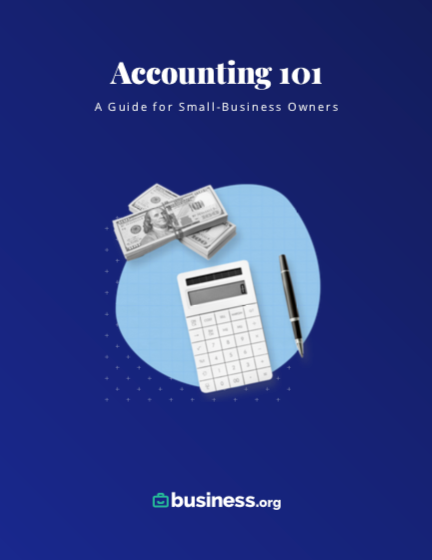
By signing up I agree to the Terms of Use and Privacy Policy .
3. List your revenue
For most product-based small businesses, revenue equals sales, or the amount goods sold—such as the amount of hair products sold by your salon, the number of baked goods sold by your cafe, or the number of printouts sold by your copy shop. But depending on the business, revenue could also include things like rent money, tax returns, or licensing agreements.
List each revenue source as its own line on your profit and loss statement. Then, once you’ve listed each source, total the amount to find your gross revenue.
4. Calculate your direct costs
After adding up your revenue, it's time to add up your direct costs, or costs related directly to producing the products or services you sell. If you sell a physical product, direct costs can also be called COGS, or cost of goods sold .
Not sure what expenses count as COGS? Let’s say you sell holiday-themed oven mitts on Etsy. To make your goods, you have to buy fabric, thread, a sewing machine, scissors, pins, patterns, and a host of other materials. The money you spend purchasing those items is your direct cost.
What if your business provides a service instead of goods? Since you don’t sell a physical product, you don’t have COGS, but you do still have direct costs. For instance, if you’re a psychologist, your office space is essential to the service you provide: without an office, you can’t offer services. So in this case, the money you pay for the office would be one of your primary direct costs.
Direct costs can also include the costs of the labor that goes directly into your product or service. Let’s imagine you’re the owner of a small lawn mowing company. Purchasing a lawn mower isn’t your only direct cost—the amount of money you pay an employee to push the lawn mower is also a direct cost.
Here's the basic formula for calculating your cost of goods sold:
Cost of goods sold = beginning inventory + purchases – ending inventory
For a more detailed breakdown of the COGS formula, check out our page on calculating COGS .
Consider using an accounting software
5. calculate your gross profit.
So now you know what your direct costs are. But do they outweigh what you charge customers for your products or services? Let’s find out: subtract your direct costs from your total revenue to get your gross profit . Hopefully, you’re left with a positive number that shows how much your business is making.
Once you've calculated your gross profit, you can also calculate your gross margin, which represents your gross profit as a percentage. Just subtract your direct costs from your gross revenue, and then divide that number by the gross revenue. Then simply multiply that number by 100.
Hint: a higher gross margin indicates higher efficiency, which is excellent for any small business.
Here's a simplified equation for calculating gross profit:
Gross profit = Gross revenue – direct costs
And if you want to turn that number into a percentage, here's how to calculate your gross margin:
Gross margin = { [Gross revenue – direct costs] / gross revenue } x 100
6. Calculate your operating and non-operating expenses
Operating expenses (OPEX) are any expenses necessary to your business that aren’t direct costs. In other words, these expenses refer to any money that doesn’t go directly into creating goods or supplying services, which is why you'll also see operating expenses referred to as indirect expenses.
Depending on the type of business you run, these could include monthly utilities, business internet and phone plans, hardware and equipment, marketing costs, office supplies, building maintenance, and equipment repairs and maintenance.
Basically, anything that impacts your day-to-day business operations should be listed as an operating expense on your income statement.
Since there are so many types of operating expenses, most income statements break down your OPEX by category. Here are a few of the most common.
Administrative expenses
Administrative expenses, also called general expenses, are any expenses you incur in the general administration of your business. You can also think of administrative expenses as costs you'd pay even if you weren't producing goods or selling services—for instance, even on a day you don't sell a single product, you're still paying for inventory storage space.
Overhead expenses
Overheads can refer to the fixed costs of running a business that don’t vary from month to month (in contrast with operating costs, which can fluctuate). If you pay the same monthly fee for your accounting software, that would count as a fixed cost , or overhead.
Depending on your business and type of income statement, overhead costs can also encompass all indirect labor and production costs. This contrasts with operating costs, which can mean the costs of actually running a business. Your accountant can help you understand more about what overheads look like at your unique business.
Additional operating costs
A few other main OPEX categories include payroll expenses, marketing costs, and sales costs. Once again, we recommend asking an accountant for personalized recommendations about how to break down your operating expenses on an income statement.
SG&A stands for selling, general, and administrative expense, and it's yet another term you might see used as a synonym for OPEX. Basically, the term encompasses everything except for COGS, direct costs, research and development expenses, and interest on business loans.
Non-operating expenses
Non-operating expenses are (hopefully) one-time expenses like legal fees, tax penalties, or interest on a business loan. Once you've calculated your operating expenses, make sure to include your non-operating expenses on your P&L statement as well.
7. Determine your net income
It’s time for the moment of truth: is your business profitable or not? Steel yourself, take a deep breath, and subtract your total expenses from your gross profit to get your net profit.
Is your net profit positive? Nice! You’re on track for financial health. Is it low, zero, or in the negatives? It’s time to reevaluate some business practices. That could mean cutting down your OPEX (operating expenses), downsizing departments, or switching raw materials manufacturers to reduce your COGS (cost of goods sold).
Other considerations: EBIT, EBT, and EBITDA
The steps above show you how to create a simple, straightforward income statement. You won’t need any more data than what we’ve listed here to fill out the U.S. Small Business Association’s template.
But maybe you’re doing in-depth business forecasting, or maybe your bank asked for more info before approving your loan. In that case, you want a longer, more detailed, and more accurate P&L statement, which means getting familiar with these abbreviations:
- Earnings before interest and taxes (EBIT): The total of your business’s net income without accounting for income taxes and loan interest.
- Earnings before tax (EBT): The total of your business’s net income plus the taxes you expect to pay (based on your business’s projected tax liabilities).
- Earnings before interest, taxes, depreciation, and amortization (EBITDA): The total of your business’s net income without accounting for income taxes, loan interest, or depreciation and amortization.
Depreciation refers to the constantly lowering value of your business’s physical assets, like a company car or office building. The more you drive the car, the more its value depreciates.
Amortization refers to the constantly lowering value of your business’s non-physical (or intangible) assets, like patents, copyrights, and trademarks.
Compare the year's best accounting software
14 days | Unlimited ($2.50/user/mo.) | ||||
30 days** | Unlimited ($10.00/user/mo.) | ||||
N/A | Unlimited | ||||
30 days | Unlimited | ||||
30 days* | Up to 25 |
Data as of 3/9/23. Offers and availability may vary by location and are subject to change. *Only available for businesses with an annual revenue beneath $50K USD **Current offer: 90% off for 3 mos. or 30-day free trial †Current offer: 50% off for three months or 30-day free trial ‡Current offer: 75% off for 3 mos. Available for new customers only
The takeaway
With the right financial documents on hand and sheer confidence in your Excel formula skills, creating a simple profit and loss statement is totally doable. Once you have the process down, feel free to pull data for a P&L statement whenever you need to—it’s the best, fastest, and cheapest way to quickly evaluate your small business’s financial health.
Want to learn more about how calculating profit and loss can help you grow your business? Check out our piece on how to effectively manage your company’s profit and loss .
Related reading
- The 6 Most Useful Financial Documents for Small Businesses
- The Best Tools for Creating a Financial Statement
- How to Calculate Net Operating Income (NOI)
- The Difference between Bookkeeping and Accounting
P&L statement FAQ
The answer largely depends on the size of your business, but P&L statement generation is one key aspect of most accounting job descriptions. Whether you have an in-house accountant, have a CPA on retainer, or pay a local accountant by the hour, the accountant you work with should be able to handily throw together an income statement in no time.
We always recommend meeting with an accountant or other financial advisor at least once when you first start creating financial documents for your business. From there, you can create your own P&L statements if you'd like to. Accounting software, including free accounting software , can draw up income statements for you with little effort on your part.
There’s a lot of financial data for you to include in your P&L statement. Like, a lot . Finding a starting point can be intimidating, but it’s much less so if you already have a great bookkeeping system in place. If you do, you should have easy access to your company’s receipts, invoices, pay stubs, credit card payments, tax data, accrued interest, and more so you can sit down and start running the numbers.
If you don’t have a great bookkeeping system in place yet, cut yourself some slack—and then get right on creating one now. (Literally now. Right now. Step away from this page and get thee to a bookkeeper.)
If you do cash transactions, start keeping receipts and storing them in a logical, orderly way. Organize your general ledger. Hire a part-time bookkeeper for a small fee or invest in bookkeeping software that keeps all your data in the same place.
Getting organized—including entering all your information into new accounting software—can be a steep learning curve. But apart from creating excellent products and services and hiring fantastic employees, there’s next to nothing more important to your business than accurate, detailed financial records, profit and loss statements included.
Are there multiple types of income statements?
Yes. There’s the typical P&L statement detailed above, and there’s a pro forma P&L, which is an income statement you fill out when you first start a business. How do you figure out revenue for a business that only just started? Well, to put it frankly, you give it your best guess—that makes it a projected profit and loss sheet, not a record of current profit and loss.
If this is your first P&L (or pro forma P&L), make sure to lowball your revenue and highball your expenses. This is a great time to detail all of your expenses in full, from the electricity bill to the replacement staplers you just bought. Having a full list of expenses can help you moderate overheads and operating costs, which helps you build frugal business practices into your company right from the start.
At Business.org, our research is meant to offer general product and service recommendations. We don't guarantee that our suggestions will work best for each individual or business, so consider your unique needs when choosing products and services.

5202 W Douglas Corrigan Way Salt Lake City, UT 84116
Accounting & Payroll
Point of Sale
Payment Processing
Inventory Management
Human Resources
Other Services
Best Small Business Loans
Best Inventory Management Software
Best Small Business Accounting Software
Best Payroll Software
Best Mobile Credit Card Readers
Best POS Systems
Best Tax Software
Stay updated on the latest products and services anytime anywhere.
By signing up, you agree to our Terms of Use and Privacy Policy .
Disclaimer: The information featured in this article is based on our best estimates of pricing, package details, contract stipulations, and service available at the time of writing. All information is subject to change. Pricing will vary based on various factors, including, but not limited to, the customer’s location, package chosen, added features and equipment, the purchaser’s credit score, etc. For the most accurate information, please ask your customer service representative. Clarify all fees and contract details before signing a contract or finalizing your purchase.
Our mission is to help consumers make informed purchase decisions. While we strive to keep our reviews as unbiased as possible, we do receive affiliate compensation through some of our links. This can affect which services appear on our site and where we rank them. Our affiliate compensation allows us to maintain an ad-free website and provide a free service to our readers. For more information, please see our Privacy Policy Page . |
© Business.org 2024 All Rights Reserved.
How to Create a Profit and Loss Forecast

Angelique O'Rourke
7 min. read
Updated May 10, 2024

An income statement, also called a profit and loss statement (or P&L), is a fundamental tool for understanding how the revenue and expenses of your business stack up.
Simply put, it tells anyone at-a-glance if your business is profitable or not. Typically, an income statement is a list of revenue and expenses, with the company’s net profit listed at the end (check out the section on income statement examples below to see what it looks like).
Have you ever heard someone refer to a company’s “bottom line”? They’re talking about the last line in an income statement, the one that tells a reader the net profit of a company, or how profitable the company is over a given period of time (usually quarterly or annually) after all expenses have been accounted for.
This is the “profit” referred to when people say “profit and loss statement,” or what the “p” stands for in “P & L.” The “loss” is what happens when your expenses exceed your revenue; when a company is not profitable and therefore running at a loss.
As you read on, keep in mind that cash and profits aren’t the same thing. For more on how they’re different, check out this article .
What’s included in an income statement?
The top line of your profit and loss statement will be the money that you have coming in, or your revenue from sales. This number should be your initial revenue from sales without any deductions.
The top line of your income statement is really just as important as the bottom line; all of the direct costs and expenses will be taken out of this beginning number. The smaller it is, the smaller the expenses have to be if you’re going to stay in the black.
If you’re writing a business plan document and don’t yet have money coming in, you might be wondering how you would arrive at a sales number for a financial forecast. It’s normal for the financials of a business plan to be your best educated guess at what the next few years of numbers will be. No one can predict the future, but you can make a reasonable plan.
Check out this article about forecasting sales for more information.
Direct costs
Direct costs, also referred to as the cost of goods sold, or COGS, is just what it sounds like: How much does it cost you to make the product or deliver the service related to that sale? You wouldn’t include items such as rent for an office space in this area, but the things that directly contribute to the product you sell.
For example, to a bookstore, the direct cost of sales is what the store paid for the books it sold; but to a publisher, its direct costs include authors’ royalties, printing, paper, and ink. A manufacturer’s direct costs include materials and labor. A reseller’s direct costs are what the reseller paid to purchase the products it’s selling.
If you only sell services, it’s possible that you have no direct costs or very low direct costs as a percentage of sales; but even accountants and attorneys have subcontractors, research, and photocopying that can be included in direct costs.
Here’s a simple rule of thumb to distinguish between direct costs and regular expenses: If you pay for something, regardless of whether you make 1 sale or 100 sales, that’s a regular expense. Think salaries, utilities, insurance, and rent. If you only pay for something when you make a sale, that’s a direct cost. Think inventory and paper reports you deliver to clients.
Brought to you by
Create a professional business plan
Using ai and step-by-step instructions.
Secure funding
Validate ideas
Build a strategy
Gross margin
Gross margin is also referred to as gross profit. This number refers to the difference between the revenue and direct costs on your income statement.
Revenue – Direct Costs = Gross Margin
This number is very important because it conveys two critical pieces of information: 1.) how much of your revenue is being funneled into direct costs (the smaller the number, the better), and 2.) how much you have left over for all of the company’s other expenses. If the number after direct costs is smaller than the total of your operating expenses, you’ll know immediately that you’re not profitable.
Operating expenses
Operating expenses are where you list all of your regular expenses as line items, excluding your costs of goods sold.
So, you have to take stock of everything else your company pays for to keep the doors open: rent, payroll, utilities, marketing—include all of those fixed expenses here.
Remember that each individual purchase doesn’t need its own line item. For ease of reading, it’s better to group things together into categories of expenses—for example, office supplies, or advertising costs.
Operating income
Operating income is also referred to as EBITDA, or earnings before interest, taxes, depreciation, and amortization. You calculate your operating income by subtracting your total operating expenses from your gross margin.
Gross Margin – Operating Expenses = Operating Income
Operating income is considered the most reliable number reflecting a company’s profitability. As such, this is a line item to keep your eye on, especially if you’re presenting to investors . Is it a number that inspires confidence?
This is fairly straightforward—here you would include any interest payments that the company is making on its loans. If this doesn’t apply to you, skip it.
Depreciation and amortization
These are non-cash expenses associated with your assets, both tangible and intangible. Depreciation is an accounting concept based on the idea that over time, a tangible asset, like a car or piece of machinery, loses its value, or depreciates. After several years, the asset will be worth less and you record that change in value as an expense on your P&L.
With intangible assets, you’ll use a concept called amortization to write off their cost over time. An example here would be a copyright or patent that your business might purchase from another company. If the patent lasts for 20 years and it cost your company $1 million to purchase the patent, you would then expense 1/20th of the cost every year for the life of the patent. This expense for an intangible asset would be included in the amortization row of the income statement.
This will reflect the income tax amount that has been paid, or the amount that you expect to pay, depending on whether you are recording planned or actual values. Some companies set aside an estimated amount of money to cover this expected expense.
Total expenses
Total expenses is exactly what it sounds like: it’s the total of all of your expenses, including interest, taxes, depreciation, and amortization.
The simplest way to calculate your total expenses is to just take your direct costs, add operating expenses, and then add the additional expenses of interest, taxes, depreciation, and amortization:
Total Expenses = Direct Costs + Operating Expenses + Interest + Taxes + Depreciation + Amortization
Net profit, also referred to as net income or net earnings, is the proverbial bottom line. This is the at-a-glance factor that will determine the answer to the question, are you in the red? You calculate net profit by subtracting total expenses from revenue:
Net Profit = Revenue – Total Expenses
Remember that this number started at the top line, with your revenue from sales. Then everything else was taken out of that initial sum. If this number is negative, you’ll know that you’re running at a loss. Either your expenses are too high, you’re revenue is in a slump, or both—and it might be time to reevaluate strategy.
- Income statement examples
Because the terminology surrounding income statements is variable and all businesses are different, not all of them will look exactly the same, but the core information of revenue minus all expenses (including direct costs) equals profit will be present in each one.
Here is an income statement from Nike, to give you a general idea:

An income statement from Nike .
As you can see, while Nike uses a variety of terms to explain what their expenses are and name each line item as clearly as possible, the takeaway is still the bottom line, their net income.
Angelique is a skilled writer, editor, and social media specialist, as well as an actor and model with a demonstrated history of theater, film, commercial and print work.

Table of Contents
- What’s included in an income statement?
Related Articles

8 Min. Read
How to Plan Your Exit Strategy

3 Min. Read
What Is a Break-Even Analysis?

1 Min. Read
How to Calculate Return on Investment (ROI)

5 Min. Read
How to Highlight Risks in Your Business Plan
The LivePlan Newsletter
Become a smarter, more strategic entrepreneur.
Your first monthly newsetter will be delivered soon..
Unsubscribe anytime. Privacy policy .

The quickest way to turn a business idea into a business plan
Fill-in-the-blanks and automatic financials make it easy.
No thanks, I prefer writing 40-page documents.

Discover the world’s #1 plan building software

Planning, Startups, Stories
Tim berry on business planning, starting and growing your business, and having a life in the meantime., standard business plan financials: projected profit and loss.
Continuing with my series here on standard business plan financials, all taken from my Lean Business Planning site, the Profit and Loss, also called Income Statement, is probably the most standard of all financial statements. And the projected profit and loss, or projected income (or pro-forma profit and loss or pro-forma income) is also the most standard of the financial projections in a business plan.

- It starts with Sales, which is why business people who like buzzwords will sometimes refer to sales as “the top line.”
- It then shows Direct Costs (or COGS, or Unit Costs).
- Then Gross Margin, Sales less Direct Costs.
- Then operating expenses.
- Gross margin less operating expenses is gross profit, also called EBITDA for “earnings before interest, taxes, depreciation and amortization.” I use EBITDA instead of the more traditional EBIT (earnings before interest and taxes). I explained that choice and depreciation and amortization as well in Financial Projection Tips and Traps , in the previous section.
- Then it shows depreciation, interest expenses, and then taxes…
- Then, at the very bottom, Net Profit; this is why so many people refer to net profit as “the bottom line,” which has also come to mean the conclusion, or main point, in a discussion.
The following illustration shows a simple Projected Profit and Loss for the bicycle store I’ve been using as an example. This example doesn’t divide operating expenses into categories. The format and math start with sales at the top. You’ll find that same basic layout in everything from small business accounting statements to the financial disclosures of large enterprises whose stock is traded on public markets. Companies vary widely on how much detail they include. And projections are always different from statements, because of Planning not accounting . But still this is standard.

A lean business plan will normally include sales, costs of sales, and expenses. To take it from there to a more formal projected Profit and Loss is a matter of collecting forecasts from the lean plan. The sales and costs of sales go at the top, then operating expenses. Calculating net profit is simple math.

Keep your assumptions simple. Remember our principle about planning and accounting. Don’t try to calculate interest based on a complex series of debt instruments; just average your interest over the projected debt. Don’t try to do graduated tax rates; use an average tax percentage for a profitable company.
Notice that the Profit and Loss involves only four of the Six Key Financial Terms . While a Profit and Loss Statement or Projected Profit and Loss affects the Balance Sheet because earnings are part of capital, it includes only sales, costs, expenses, and profit.
Hi, In case of bank financing for machineries and working capital, how can it be broken down in to the expense stream? ( capital + interest)
When you spend on assets is not deductible from income, and is therefore not an expense. What you spent to repay the principle of a loan is not deductible, and therefore not an expense. The interest on a loan is deductible, and is an expense.
Excuse me, may I know if the project profit & loss should plan for the first year only or for year 1-3 in business plan of a new company?
Kattie Wan, I recommend for normal cases the projected profit and loss monthly for the first 12 months, and two years annually after that. There are always special cases, though; every business is different.
Leave a Reply Cancel reply
Your email address will not be published. Required fields are marked *
Save my name, email, and website in this browser for the next time I comment.

The quickest way to turn a business idea into a business plan
Fill-in-the-blanks and automatic financials make it easy.
No thanks, I prefer writing 40-page documents.

Discover the world’s #1 plan building software
How to Prepare a Profit and Loss (P&L) Statement for Your Startup
| Written by
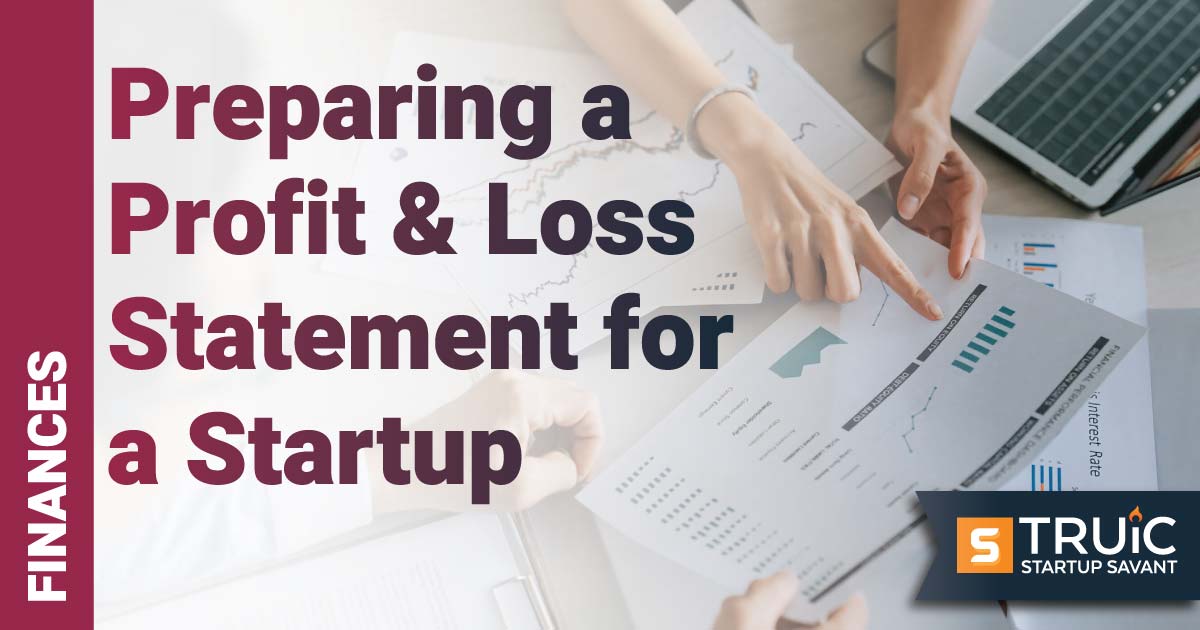
Monitoring your startup’s finances is an integral part of knowing how to sustain and grow your business. A profit and loss (P&L) statement is one key element to measuring the health of your startup’s finances.
This guide walks you through what a P&L statement is, why your company needs it, and how to prepare a profit and loss statement for your startup.
P&L Statements for Startups
Tracking a company’s profit and loss provides entrepreneurs with insight into their startup’s financial wellness and performance over a period of time, allowing them to make better decisions for their business.
While it is possible to prepare a P&L statement using financial management software such as QuickBooks , knowing how to manually issue one can be valuable for entrepreneurs. Especially if they are looking to deeply familiarize themselves with their company’s financial position.
What Is a Profit and Loss statement?
A profit and loss (P&L) statement, commonly referred to as an income statement , is a summary of the net profit and loss of a company over a period of time. This is one of three financial reports businesses are required to prepare annually and quarterly, along with a cash flow statement and balance sheet .
The P&L statement, specifically, indicates whether a business is profitable or not, how much profit is being made, and helps when filing taxes.
Why Do I Need a P&L Statement for My Startup?
As mentioned above, P&L statements are one of the three reports businesses are required to issue. However, these statements also provide value for entrepreneurs and their teams to better their company’s financial position.
Tax Preparation
Not only is a P&L used by startup founders to gauge the financial performance of their company, but the Internal Revenue Service (IRS) uses these statements to make tax assessments as well.
Generates Feedback
The amount of profit versus expenses may help you better understand how your product or service is performing. This feedback may help you troubleshoot and adapt to better reach your target market.
How to Create a P&L statement
Many businesses choose to use software to track their finances that can easily issue a profit and loss statement. However, if you’d rather prepare one manually, here are six easy steps to create a P&L statement for your startup.
1. Choose Your Time Period
Whether you’re issuing an annual, quarterly, or monthly P&L sheet, your first step is to determine the reporting period you’re calculating for. Then, gather all of the information required to calculate revenue, expenses, and any other financial information from that period to create your statement.
2. Calculate Revenue
Next, calculate your company’s revenue for your reporting period. This will include any money you gain from the sale of your company’s profits or services.
It is helpful to keep these sales documented and organized as they occur.
3. Calculate Expenses
After you have determined the amount of money you have coming in, you need to calculate the money your company is spending, otherwise known as expenses or costs of goods sold .
This, however, does not include salaries, leases, or any other fixed expenses.
4. Find the Gross Profit
Your next step is to determine your gross profit by subtracting your operating expenses (Step 2) from your revenue (Step 3) listed above.
5. Add In Overhead Costs
Then, add your overhead costs . These are the fixed expenses that typically don’t change based on your revenue, such as salaries, rent, insurance, and other continuous expenses.
Subtract the total of your overhead costs from your gross profits to determine your operating income.
Keep in mind that if you have any non-operational expenses or revenue, such as interest or dividends, these will need to be added or subtracted from your operating income.
6. Assess the Net Profit
Once you have your operating income , you will know your net profit. This is how much profit or loss your company had over the reporting period after revenue and expenses.
You can use this number to assess the financial health of your company and make changes if needed to avoid losses in the future.
P&L Statement Tools for Startups
While it is possible to issue profit and loss statements manually, using financial management or accounting software makes the process easier and faster. Here are some great options for startup profit and loss statement tools.
1. QuickBooks
With QuickBooks ’ suite of accounting software tools, startups can easily manage their finances as well as prepare profit and loss statements with ease.
If you’re looking for a free P&L template as well as additional resources, Lili offers a variety of information. Plus, if you utilize Lili’s accounting software, profit and loss statements are automatically generated for you.
Lili is a financial technology company, not a bank. Banking services provided by Sunrise Banks N.A., Member FDIC.
3. FreshBooks
Finally, FreshBooks offers a free downloadable P&L template that is compatible with Google Sheets, Google Docs, PDFs, and more.
Further Reading
- Best Financial Tools to Track Startup Growth July 2, 2024
- Guide to Financial Modeling for Startups July 25, 2024
- Startup Costs Entrepreneurs Should Know July 25, 2024
Topics to Explore
- Startup Ideas
- Startup Basics
- Startup Leadership
- Startup Marketing
- Startup Funding
Browse Tags
Profit and loss statements explained (+ templates and examples)
Wouldn’t it be great if you could know what the future holds for your business?
Well, you kind of can, and we aren’t talking about magic here!
What we’re referring to is the profit and loss statement (P&L), which gives you insight into how well your business is doing. Or how badly , for that matter.
In fact, experts consider a profit and loss statement one of the most common financial documents in any sector and business plan. You may even call it mission-critical.
In this in-depth guide, we’ll cover the essential elements of profit and loss statements, including:
- Profit and loss statements most common types,
- Examples of profit and loss statements,
- Profit and loss statement templates,
- Tested tips for making better P&L statements, and more.
Let’s start with a few general remarks that you need to know first!

Table of Contents
What is a profit and loss statement?
A profit and loss statement is a financial statement that typically covers the following items:
- Revenues,
- Costs, and
Moreover, a profit and loss statement usually consists of company revenues, costs, and expenses within a specific period, like a month, a quarter, a fiscal year — or even a week.
When done properly, a P&L can help protect the financial bottom line of a company by offering deeper insights into how a business can reduce costs and increase revenue.
In other words, a profit and loss statement is a handy tool that allows you to scrutinize the financial health (or lack thereof) of your company.
Interestingly, a P&L statement goes by many names, depending on the experts you talk to. Here’s a quick list of some of the terms:
- Expense statement,
- Statement of profit and loss,
- Income statement, etc.
In any case, P&L statements summarize a company’s revenues, expenses, and costs in one form or another and are typically performed by in-house or outsourced accountants. But, if you’re a finance-savvy manager, you can even perform one yourself — at least the less detailed P&L statements.
Sidenote: Public companies are required by law to make their P&L statements publicly available — specifically, on their web page’s investor relations section.
Because of the insight they offer, profit and loss statements allow managers, leaders, and investors to make better investing decisions or spot underperforming business areas.
To get you on the same page with creating your P&L statements the right way, let’s take a quick look at 2 universal methods for creating profit and loss statements.
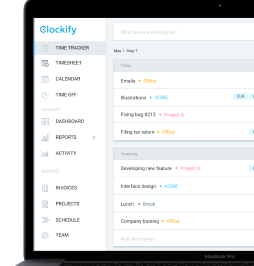
FREE FOREVER • UNLIMITED USERS
Free time tracking software
Track time and calculate payroll with Clockify, time tracker used by millions.
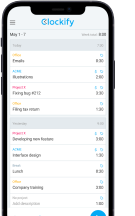
2 Universal methods for creating a P&L statement
A profit and loss statement comes into existence thanks to 2 types of accounting methods — either the accrual method or the cash method. In simple terms, these universal accounting methods are tools for tracking and recording expenses in certain ways.
Still, the method you choose can make all the difference.
For illustration, investors often inspect corresponding types of P&L statements published by same-sector companies of similar size. After crunching the numbers, they spot trends in managing expenses and decide to invest in one company rather than another.
For clarity’s sake, suppose a company decides to use the cash method, although using the accrual method would have provided more insight into the company’s financial performance. In this case, the investors may disapprove of the inappropriate use of accounting methods, leading to the investor deciding not to invest in the company.
To explore further, we’ll next discuss the accrual and cash method in more detail.
Accounting method #1: Cash method
Accountants often call this “the cash accounting method.” Companies use the cash method only when they need to record instances of cash changing hands — that is, when cash actually enters or leaves the business.
An example of this would be if a business counts their cash on hand and the money they paid for expenses.
Accountant Francis Fabrizi of Keirstone Limited explained that smaller companies typically prefer the cash method of accounting:

“Some small businesses may choose to use the cash method for accounting purposes, as the accrual method can be more complex and time-consuming to use.”
Yet, this approach comes with a major downside, as it accounts for cash only when it is either paid or received.
Accounting method #2: Accrual method
Unlike the cash method, the accrual method records profit only when it’s earned. In a nutshell, this means that a company records expenses or revenue after the service has been provided, regardless of the fact that it hasn’t received the cash for offering the service.
Simply put, companies typically use the accrual method for funds that they expect to receive at a future date.
In the subscription age, the accrual method is a much-loved method for recording revenue and sales.
For example, picture an on-demand streaming service like HBO GO or Netflix. These companies use the accrual method to record revenue on their P&L statements, although they haven’t collected the payment for the service — but expect to receive it at a given subscription renewal period.
In fact, the accountant we mentioned previously, Francis Fabrizi, clarified that the accrual-based method is the preferred method for financial accounting:
“The reason is that the accrual method provides a more accurate picture of a company’s financial performance. This is because it recognizes revenue and expenses in the period in which they are actually incurred, rather than when cash is exchanged. The accrual method helps to ensure that revenues and expenses are matched in the same accounting period.”
As we have seen, the cash and accrual methods of accounting come with their pros and cons. So, choose the one that fits your needs, your company’s reporting, and your client’s requirements.
🎓 Clockify Pro Tip
Whichever accounting method you pick, bear in mind that the process of collecting data for your profit and loss statement is best done using accounting software. Take a look at some of the best on the market:
- 15 best free accounting software tools
What is the structure of a profit and loss statement?
By now, you might wonder what is in a profit and loss statement . To answer your question, the structure of a typical P&L statement looks something like this:
- Revenue: the total amount of money that the business has earned during a given accounting period (a week, month, quarter, calendar year, or fiscal year).
- Cost of goods sold (COGS): the cost of the services or products sold by the company; includes items like materials and direct labor.
- Gross profit : the difference between revenue and cost of goods sold; also known as gross margin and gross income.
- Operating expenses: the cost of operating the company, including rent, utilities, payroll, general and administrative costs; includes anything not covered by the cost of goods sold.
- Operating income: the difference between gross profit and operating expenses; shows how much profit a business makes from its activities prior to deducting interest and taxes.
- Non-operating items: interest expenses, interest income, gains or losses from selling assets, and other non-operating expenses or non-operating income.
- Net income, net profit, or bottom line: the profit after the company has deducted all expenses; represents the company’s final figure or overall loss or profit for the corresponding period.
Sure, with all this information in mind, a P&L statement may not infuse you with enthusiasm, but it’s critical that you still prepare it regularly.
Anyway, don’t worry about it — we’ll provide you with a few examples and templates that’ll help you craft your own profit and loss statement. But before we get into that, let’s check out a few common types of P&L statements.
Explore the difference between gross salary and net salary in our blog post:
- Gross pay vs. net pay — Definition, calculation, key differences
What are the common types of profit and loss statements?
For your convenience, here’s a list of a few types of P&L statements you can use, depending on whether you’re a small, medium, or large company.
| Name of the statement | How it benefits your business | Ideal for |
|---|---|---|
| Calculates net income by deducting total expenses from total revenue in a single step | Smaller companies, like service companies and sole proprietorships | |
| Breaks down expenses into categories like operating expenses and cost of goods sold, giving a thorough insight into financial performance | Complex, large businesses, like construction companies and factory facilities | |
| Lets you compare your current revenues, costs, and expenses with those in prior financial statements | Any-sized companies, including small, medium, and large businesses | |
| Enables you to forecast the financial status of your company under speculative circumstances | Any-sized companies, including small, medium, and large businesses | |
| Helps you see how particular products or services contribute to the profit of your business | Any-sized companies, including small, medium, and large businesses | |
| Provides a snapshot of the financial performance across the business’s subsidiaries | Mid-sized and large companies |
Regardless of the period for which you choose to implement your P&L statement — weekly, monthly, quarterly, or yearly — make sure to pick the right format from the list above that fits your company preferences and needs.
Speaking of time periods, we’ll next explore 2 criteria that you must not lose sight of when creating your profit and loss statement.
2 Criteria to consider before crafting a P&L statement
At this point, you need to know some types of P&L statements can be extraordinarily simple, and others can be incredibly complex. Certainly, some of them fall somewhere in between, and we’ll get to those.
For now, we can classify types of profit and loss statements based on 2 criteria:
- Period the statement covers, and
- Depth of data the statement provides.
In essence, we can refer to them as periodic and detailed P&L statements, but the actual format varies based on a company’s preferences and reporting standards.
Let’s go over each of those 2 criteria of profit and loss statements in more detail.
Criterion #1: Period the statement covers
In terms of timeframes, P&L statements are categorized into 4 types:
- Weekly P&L statements allow you to get a sneak preview of your company’s financial health for the past week,
- Monthly P&L statements deliver insight into a company’s profitability or losses in the course of a calendar month,
- Quarterly P&L statements illustrate financial performance (or lack thereof) over a 3-month period, and
- Yearly P&L statements provide a snapshot of a company’s financial performance over the span of a fiscal year.
Make sure you choose one or more for optimal business results — because, in contrast, a lack of periodic P&L statements can stifle your business growth.
For instance, even though people may be queueing up in front of your business to buy your product, that doesn’t necessarily mean that you’re making great profits. In fact, only after conducting a periodic P&L statement can you compare your profits with your costs.
Understandably, all P&L statements need to cover some period of time, whether a week, month, or year. So, let’s consider the depth of your profit and loss statement next.
Criterion #2: Depth of data the statement provides
You can divide the types of profit and loss statements in terms of the depth they go into to describe the financial status of a company.
Rule of thumb — the more depth you go into, the better your chances of spotting inconsistencies and issues.
In short, a smaller company can easily analyze its bottom line with the single-step profit and loss statement. In contrast, a large multinational corporation may need to turn to a comparative profit and loss statement for maximum benefits.
For example, elaborate P&L statements can benefit companies looking to cut their general expenses, like amortization and depreciation costs, when they conduct a profit and loss statement.
Depreciation and amortization refer to the practice of estimating the value of company assets over time. Yet, some businesses neglect to factor in these items, leading to failure in projecting long-term growth.
With these important criteria out of the way, let’s explore 3 examples to make the process of creating profit and loss statements more tangible.
Examples of a profit and loss statement
Now you’re familiar with the structure and types of P&L statements — kudos!
So, let’s dive into a few real-world scenarios where you can implement P&L reporting. For illustration, here are the 3 profit and loss statement examples we’ll cover:
- Small bakery P&L statement,
- Product/service company P&L statement, and
- Restaurant P&L statement.
Let’s up your financial game with a few real-life examples!
#1 Example of profit and loss statement: Small bakery
Suppose you want to start a business in Alabama , and you decide it’s going to be a small bakery. For a while, you successfully operate your company. After a few months, it’s high time you requested a profit and loss statement to be done to assess how well you’re doing.
In this case, you’ll use the single-step P&L statement because it neatly and simply analyzes the bottom line of a small business. For this example, it suffices to use the cash method of accounting, as this method records instances when cash actually enters or leaves the business.
To start things off in the right direction, begin by looking at baked goods and beverages — that’s the entire company revenue at this stage. How much the bakery makes and sells, i.e., your revenue, impacts the financial bottom line.
Next, you need to consider costs, like utilities, wages, and ingredients. Finally, you’ll get the net income that depicts the loss or profit of the business for the given period.
For practical purposes, we’ll offer a simplified version of the single-step P&L statement for your small bakery.
Note that the list of revenue items and costs listed below isn’t exhaustive, as you’ll probably have more things to add. Therefore, the overview below serves as an example.
| Period covered: June 2024 | |
|---|---|
| : Bread Unlimited | Currency: USD |
| : Baked goods and beverages sold (A) | 3,000 |
| : Ingredients, utilities, employee wages (B) | 2,500 |
| Bakery’s profit after deducting costs from revenue (A – B) | 500 |
#2 Example of profit and loss statement: Product/service company
A profit and loss statement isn’t confined to small businesses, like a bakery in Alabama. You can use it for complex organizations as well.
For this example, it’s recommended that you use the accrual method of accounting. The reason is that this method records expenses or revenue after they’ve provided the service — although the company hasn’t received the cash yet.
The accrual method is used for companies that need to get a more detailed overview of their financial performance. In other words — when the stakes are high.
To create a P&L statement for a software company, you first need to consider the revenue from subscriptions or product sales. After that, it’s appropriate to look into costs (COGS), like licensing, hosting, and customer support costs — all leading you to your gross profit. In short, you get the gross profit by deducting COGS from revenue.
Also, you need to consider the staff’s salaries, rent, and marketing expenses — all operating expenses. When you’re done with that, you need to evaluate the operating profit by deducting operating expenses from gross profit. The next step is to examine your taxes, interest on loans, and other necessary expenditures — your non-operating items.
Finally, you get the net profit — that is, the final figures showing you how well your business is performing.
To make it even more concrete, here’s a simplified breakdown of a multi-step P&L statement you could use for a software company — let’s call them InvincibleDevs .
| Period covered: Q1 2024 | |
|---|---|
| : InvincibleDevs | Currency: USD |
| : Subscriptions (or product sales) | 10,000 |
| : Licensing, customer support, software development | 3,000 |
| : Revenue – costs | 7,000 |
| : Salaries, office rent, marketing | 5,000 |
| : Gross profit – operating expenses (A) | 2,000 |
| Taxes, interest on loans, depreciation, amortization, etc. (B) | 500 |
| (or net loss): A – B, the final financial result after deducting non-operating items from operating profit | 1,500 |
#3 Example of profit and loss statement: Restaurant
With millions of restaurants spread throughout the world, it might be interesting to explore how a P&L statement can impact their profitability.
For illustration, we can take a single month’s worth of meals and pull it through a comparative P&L statement. In particular, let’s do a summary of the revenue and costs for January and February 2024. For this example, it’s best to use the cash method of accounting, as accountants typically record revenues and expenses only when the cash changes hands.
First, all the meals you typically sell during a month amount to your revenue. After you deduct the cost of goods sold — like ingredients — and labor costs from the revenue, you get a gross margin. Bear in mind that the cost of goods sold and labor costs are often jointly referred to as prime cost .
Second, you need to subtract the operating expenses, including wages of the entire kitchen and wait staff, plus the rent. These expenses are typically fixed.
Third, you have to cover the utilities, marketing expenses, and depreciation — all represented as general and administrative expenses (often also called non-operating expenses ).
In the end, our imaginary restaurant is left with the net income on that single month’s worth of meals for January and February 2024.
To make it more concrete, here’s what the restaurant budget for a single month’s worth of meals may look like in a comparative P&L statement:
| January 2024 | February 2024 | |
|---|---|---|
| Palate Paradise | Currency: USD | Currency: USD |
| : Meals and beverages sold (A) | 1,000 | 950 |
| : Food and ingredients (B) | 200 | 220 |
| Wait and kitchen staff salaries, payroll taxes (C) | 220 | 220 |
| : A – B — C | 580 | 510 |
| Rent | 290 | 290 |
| Depreciation, utility charges, marketing | 220 | 240 |
| Restaurant’s profit after deducting all costs and expenses from revenue | 70 | –20 |
Speaking of managing restaurants, here’s a list of the 10 of the best management software to operate any restaurant:
- 10 Best restaurant management software in 2022
3 Tested tips to make better P&L statements
As a business owner, it’s sometimes difficult to remember to do everything that needs to be done — from paying employees and contractors to recording and submitting all the required information to the authorities.
That’s why we’ve laid out 3 simple yet effective ways to make your profit and loss statements more akin to a walk in the park.
Tip #1: Track your time to better manage labor costs
You can’t possibly know everything that’s going on in your business if you don’t track what and when employees are doing. So, to improve your bottom line, you’ll have to keep tabs on the labor cost of people involved in your company.
For example, a time-tracking system like Clockify lets you add billable rates for your clients — and define cost rates for your workforce. In Clockify reports, you get to compare your billable amounts (what you charge your clients) with your cost amounts (what you pay your employees).
As a result, you can better track profitability.
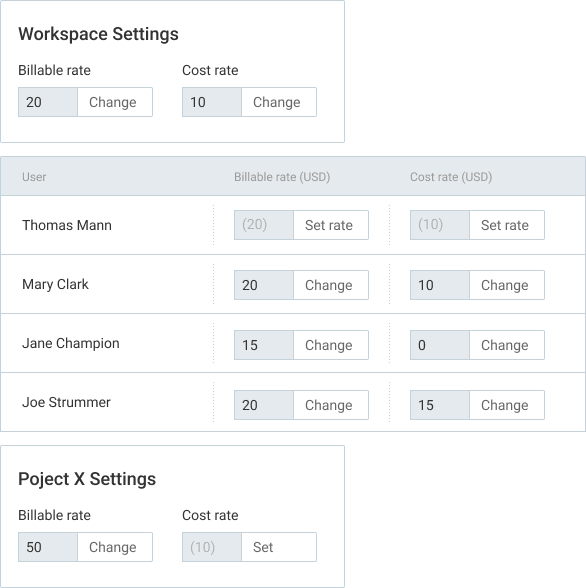
As soon as you enable cost rates in Workspace settings, you can apply billable rates and cost rates to any project, client, and employee. This allows you to create more detailed profit and loss statements because you’ll know exactly how much you charge your clients and pay your workforce.
So, the next time you want to make sure you’re meeting your financial goals, remember to start tracking your productivity and doing the same for your employees. Doing so will help you see where time is slipping through the cracks — and thereby ruining your business.
Tip #2: Keep tabs on expenses to protect your bottom line
A study that surveyed more than 200 Nordic organizations found that around 20% of receipts don’t make it into expense reports . That’s a sad reality for many companies nowadays. Yet, the cure to this problem is simple: Digitize your receipts!
For example, you can use an expense-tracking app like Clockify to track costs for project fixed fees by categories, like sum or unit. After inserting expenses, Clockify generates a fitting invoice that reflects all the expenses by category.
To tie it up with your P&L statement, you can track how much your team is spending on operating expenses, like marketing or purchasing office supplies.
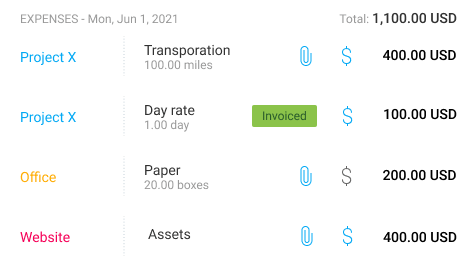
In fact, you can organize your expenses per many items, including:
- Team member,
- Project,
- Category, and more.
Whether you work as an accountant or just want to get a head start on tracking your expenses, check out our informative article on this topic:
- How to keep track of expenses
Tip #3: Manage your time better to increase productivity
This point bears repeating in any sector — create an impenetrable time management system.
If your accountants and workforce are exhausted, they can make errors in their work, including what goes into your P&L statement.
But suppose you decide to make time management a priority. In this case, one of the intended consequences will be an improvement in your company’s bottom line.
Free time management app
Take control of your time and maximize productivity with effortless time tracking.
So, here are a few practical tips for managing your time well when crafting a P&L statement:
- Type in the title of your task in your time-tracking app,
- Click on the dollar sign to mark your time as billable,
- Start the timer to track your billable hours,
- Record expenses in your dedicated time billing software, and
- Create invoices for the services you provided.
As soon as you implement these techniques, you’ll be on your way to creating better financial statements and a work environment that drives stellar performance.
Get bite-sized advice on how to manage your time even better in our comprehensive guide:
- Everything you need to know about time management (+ tips)
Profit and loss statement templates
Now you have everything you need to grow your knowledge about P&L statements. But it’s prime time we get to a few useful templates you can use to craft your own profit and loss statement.
In this section, we’ll look into 3 templates of profit and loss statements:
- Single-step P&L statement template,
- Multi-step P&L statement template, and
- Comparative P&L statement template.
We hope you’re excited as we are — let’s dig in!
Profit and loss template #1: Single-step P&L statement
The single-step P&L statement is a simple financial tool that lets you get a bird’s-eye view of how much money your business is making or losing. Yet, its use doesn’t spread beyond small businesses — like our small bakery in Alabama. Larger companies typically avoid this when making long-term decisions.
The Single-step P&L statement template is useful if you’re just starting out and you’d like to calculate your total income without having to create a single-step P&L statement from scratch.
This template is also practical for getting a snapshot of your expenses and cost of goods sold. In fact, it’s called single-step because it gives you a picture of the loss or profit in a single step. Yet, it doesn’t list things like operating and non-operating costs — things that still impact the bottom line.
Pros of the Single-step P&L statement template :
- Makes record-keeping easy due to its simplicity, and
- Focuses on the company’s financial bottom line.
Cons of the Single-step P&L statement template :
- Doesn’t distinguish between operating costs and non-operating costs, and
- Makes it hard to determine the sources of many activities, which discourages investors from investing in the business.
How best to use the Single-step P&L statement template?
You have 2 formats to choose from for your template: a Google Sheets file and an Excel spreadsheet.
If you click on the Google Sheets link below, a new screen will appear with the prompt: Would you like to make a copy of the Single-step P&L statement template?
Click on Make a copy, and you’ll get an editable copy of the Single-step P&L statement template.
If you go with the Excel spreadsheet, clicking on the link will save the document to your device.
In any case, the document will be empty, with many zeroes. As soon as you begin inserting your digits, it will start to take shape.
After you’ve inserted your company’s details and the period you want to cover, start by filling in the Revenue and gains column by adding details such as:
- Sales and interest revenues,
- Gains on sales of assets, and other revenues.
Next, you need to populate data in the Expenses and losses column, including:
- Cost of goods sold,
- Depreciation,
- Office supplies,
- Rent, and other expenses.
To get the net income, you’ll need to subtract the Total of expenses and losses from the Total revenue and gains .
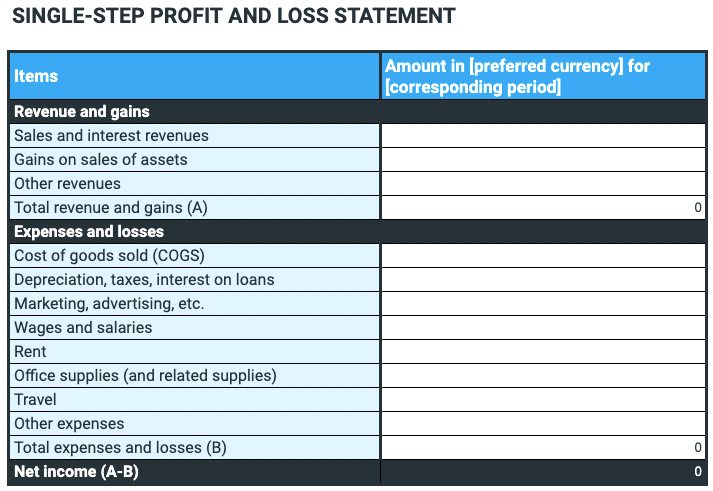
⬇️ Download the Single-step P&L statement template (Google Sheets)
⬇️ Download the Single-step P&L statement template (Excel)
Profit and loss template #2: Multi-step P&L statement
The multi-step P&L statement is a more detailed type of profit and loss statement that includes multiple subtotals. For example, it separates the operating expenses and operating income from non-operating expenses and non-operating income. In turn, this helps a company find out which areas are performing as expected or poorly.
Suppose a budget item from your non-operating income — like insurance proceeds — is through the roof. In this case, the multi-step P&L statement provides you with details about this item. In contrast, the single-step P&L statement typically attaches this non-operating income to other budget items, which doesn’t give a proper explanation for the rise in insurance proceeds.
Filing out this template is time-consuming, but it helps you get more in-depth into your financial situation and is meant for mid-sized and large businesses.
Pros of the Multi-step P&L statement template:
- Calculates gross profit and operating income easily, and
- Offers deeper insight into operating trends and financial performance.
Cons of the Multi-step P&L statement template:
- Lacks simplicity, making it hard for non-finance persons to interpret, and
- Takes plenty of time and effort to create one.
How best to use the Multi-step P&L statement template?
If you click on the Google Sheets link below, a new screen will appear with the prompt: Would you like to make a copy of the Multi-step P&L statement template?
Click on Make a copy, and you’ll get an editable copy of the Multi-step P&L statement template.
After you’ve inserted your company’s details and the period you want to cover, start by filling in details such as:
- Sales or revenue, and
- Cost of goods sold.
Next, you need to populate data in the Operating expenses column, including:
- Selling expenses, and
- Administrative expenses.
This brings you to the Operating income , which you get when you subtract Total operating expenses from your Gross profit . The line item Operating income is critical, as it lets you see if your operating activities are generating profit or not. Depending on the industry, an operating activity can fall into many categories, like manufacturing, sales, marketing, and others.
Next, you need to fill in data for:
- Non-operating income, and
- Non-operating expenses.
To get the net income, you’ll need to add Operating income to the Total non-operating expenses . For simplicity’s sake, net income is the bottom line of a company. In other words, it represents the amount your business has made after deducting expenses, taxes, allowances, and other costs.
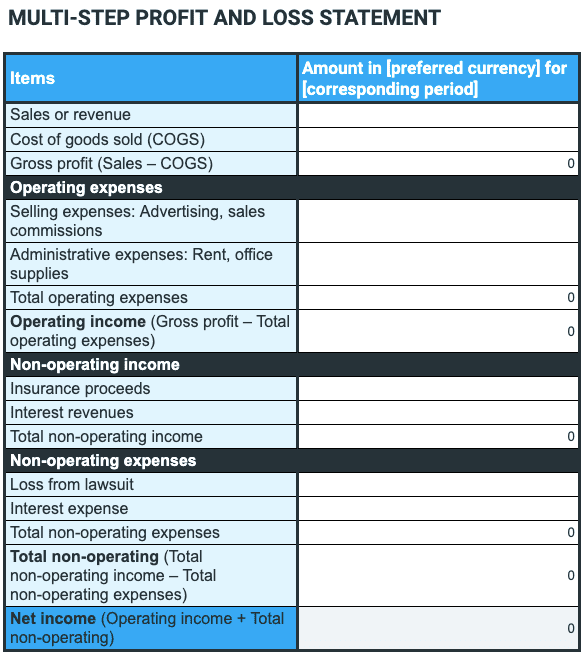
⬇️ Download the Multi-step P&L statement template (Google Sheets)
⬇️ Download the Multi-step P&L statement template (Excel)
Profit and loss template #3: Comparative P&L statement
The comparative P&L statement is a complex type of a profit and loss statement that compares different accounting periods for one company — or multiple different-sized companies. Experts praise it as one of the most useful P&L statements, as it presents investors and managers with changes in percentage and numbers from one period to the next.
The Comparative P&L statement template presents figures of expenses and income on a single page without having to go back to previous P&L statements and compare them to current ones.
This template allows you to spot problems and trends over different accounting periods. In fact, since it’s digital, you can easily correct numbers and do necessary calculations online without having to print them out.
Pros of the Comparative P&L statement template:
- Provides a clear comparison between multiple accounting periods, and
- Simplifies analysis of sales and net income line items.
Cons of the Comparative P&L statement template:
- Benefits the company only if it uses identical accounting principles consistently to produce such P&L statements (like the accrual or cash method), and
- Fails to be practical when the company branches out into new lines of business.
How best to use the Comparative P&L statement template?
If you click on the Google Sheets link below, a new screen will appear with the prompt: Would you like to make a copy of the Comparative P&L statement template?
Click on Make a copy, and you’ll get an editable copy of the Comparative P&L statement template.
After you’ve inserted your company’s details and the period you want to cover, start by filling in details for the Operating revenue column, such as:
- Net sales, and
Next, you need to populate data in the Operating expenses and General and administrative expenses columns, including:
- Salaries and wages,
- Depreciation,
- Payroll taxes,
- Insurance, and others.
This brings you to the Total operating expenses column, which you get when you add Total selling expenses to the Total general and administrative expenses .
- Income from operations,
- Interest expenses,
- Taxes, and others.
To get the net income, you’ll need to subtract Net income before tax from Taxes .
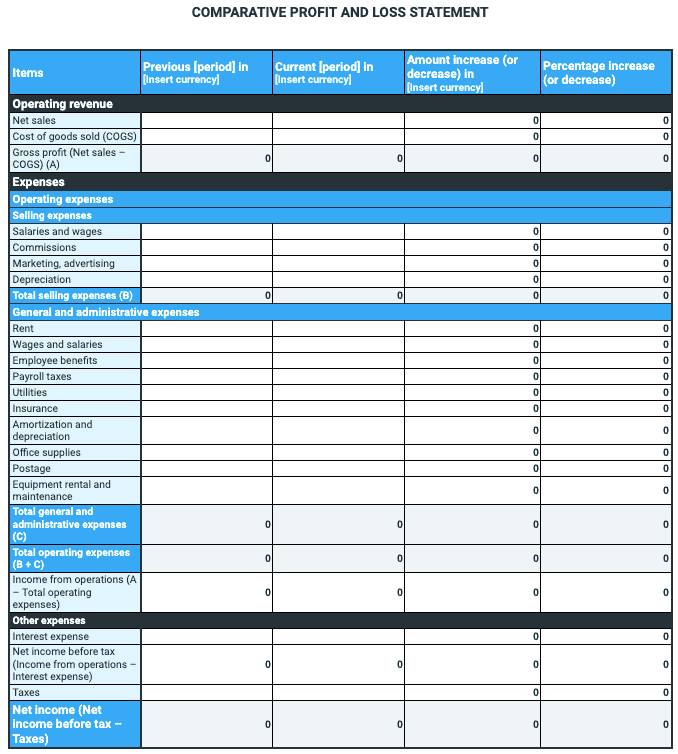
⬇️ Download the Comparative P&L statement template (Google Sheets)
⬇️ Download the Comparative P&L statement template (Excel)
Note: Even though our P&L statement templates are pretty straightforward, it’s always best to consult with an accountant before making a profit and loss statement official. Clockify is not responsible for any losses or risks incurred should this example be used without further guidance from professionals.
FAQ about profit and loss statements
In this segment, we’ll take a look at a few frequently asked questions people face when they start working on a profit and loss statement.
What is the difference between a cash flow statement, balance sheet, and P&L?
Companies typically make 3 types of financial statements on their financial performance annually, quarterly, and monthly, including:
- Cash flow statement — a financial document that lists the sources of cash deriving from investment, operating, and financing activities,
- Balance sheet — a financial statement that looks into equity, liabilities, and assets that the company has in its possession, and
- Profit and loss statement or income statement — a financial document that details revenues, sales, expenses, and costs in one form or another, depending on the company’s reporting standards.
But when it comes to disclosing this information, not all companies have the same responsibilities toward authorities.
Which companies have to give away financial statements?
Public companies are required by law to file regular reports with the U.S. Securities and Exchange Commission. Yet, most private companies don’t have to disclose this information — at least the ones with less than $10,000,000 in assets and with more than 500 owners who hold securities (a financial instrument that provides individuals with a form of company ownership).
Private companies that aren’t subject to these criteria often still provide these financial statements to the authorities. The reason? Well, this information gives financial experts deeper insight into how they do business. As a result, investors can make informed decisions about investing, and buyers can decide whether they want to buy or sell a company.
Paired together, the cash flow statement, balance sheet , and profit and loss statement comprise 3 critical components that help managers and investors explore a company’s financial performance over a given accounting period.
Is a P&L the same as an income statement?
Yes, profit and loss statement and income statement are synonyms for the financial document that gives you insight into your company’s financial performance. They include expenses, revenue, and net profit for a given accounting period (a week, month, quarter, or year).
Is P&L the same as a balance sheet?
A profit and loss statement differs from a balance sheet by focusing on expenses and revenue. On the other hand, the balance sheet looks into:
- Liabilities,
- Assets, and
- Equity.
Yet, the balance sheet is a critical companion of the P&L statement in assessing the overall health of a business.
Does P&L include revenue?
Yes, a profit and loss statement always includes revenue and expenses. Line items on revenue, sales, expenses, and costs are the identifying marks of P&L statements.
Is a P&L a cash flow statement?
No, a profit and loss statement isn’t the same as a cash flow statement. Unlike the P&L statement, the cash flow statement lists the cash sources stemming from investment activities, operating activities, and financing activities. In other words, the cash flow statement doesn’t include information on expenses and revenue — as is the case with the P&L statement.
Wrap-up: Prepare regular P&L statements to learn if your business operations are profitable
To make your profits shine, you surely have to go through a strenuous process. And it’s so much more than mere cost management!
In fact, you need to be aware of what exactly happens with your company’s money — and this is where a profit and loss statement comes into play.
In a nutshell, P&L statements allow accountants and managers to make more informed decisions by giving them insight into which activities are a waste of money and which generate profit.
For this and a wealth of other reasons, we geared you up with everything that can help you make the best profit and loss statements, paired with examples and templates.
In summary, here are the main takeaways:
- Choose a simple or complex type of a P&L statement, depending on your needs,
- Harness the power of expense-tracking software to make the process effortless,
- Use templates to speed up the creation of a P&L statement,
- Implement a P&L statement regularly to keep tabs on sales and revenues, and
- Track and manage your time by using time and billing software.
If you follow just a few of these pieces of advice, you’ll be on your way to creating profit and loss statements that will amaze investors and managers alike.
Sources for the table:
- Khatabook, Comparative Income Statement: Examples, Analysis and Format
- Library of Congress, Research Guide on U.S. Private Companies
- Millie Atkinson, 2017, Income Statements Essentials
- Risks and benefits of handling digital receipts, Eurocard, 2021
- Sandy Baruffi, 2021, The Basics Of Understanding Financial Statements: A Guide To Understanding Financial Reports
- U.S. Securities and Exchange Commission, The Laws that Govern the Securities Industry
- U.S. Securities and Exchange Commission, What does it mean to be a public company?
- WallStreetMojo, Single-step Income Statement
Explore further
Business Regulations

Freelancers & Contractors

Free time tracker
Time tracking software used by millions. Clockify is a time tracker and timesheet app that lets you track work hours across projects.

Profit and Loss Statements 101 (with Template)
Bryce Warnes
Reviewed by
Janet Berry-Johnson, CPA
April 26, 2024
This article is Tax Professional approved
Want to know how profitable your business is? The best way to find out is to create a profit and loss statement.
Here’s how you put one together, how to read it, and why profit and loss statements are important for running your business.
I am the text that will be copied.
What is a profit and loss statement?
A P&L statement (sometimes called a statement of operations) is a type of financial report that tells you how profitable your business was over a given period. It shows your revenue, minus expenses and losses. The result is either your final profit (if things went well) or loss .
The P&L statement is one of the three most important financial statements for business owners, along with the balance sheet and the cash flow statement (or statement of cash flows).
One of the most common reasons small businesses start producing profit and loss statements is to show banks and investors how profitable their business is.
When profit and loss statements are meant to be shared outside a business, they’re called income statements. A P&L statement is for internal use only. Other than that, the two statements are essentially the same.
Profit and loss statement example
We’ve created a profit and loss statement for an imaginary small business—Terracotta Warriors, a supplies store for potted plant enthusiasts.
Terracotta Warriors Inc.
Income Statement
For Year Ended Dec. 31, 2021
| Category | Amount |
|---|---|
| Sales Revenue | $57,050.68 |
| Cost of Goods Sold (COGS) | $24,984.79 |
| Gross Profit | $32,065.89 |
| General Expenses | $11,049.55 |
| *Rent | $9,000.00 |
| *Bank & ATM Fee Expenses | $9.43 |
| *Equipment Expenses | $742.40 |
| *Marketing Expenses | $503.53 |
| *Merchant Fees Expenses | $794.19 |
| Operating Earnings | $21,016.34 |
| Interest Expense | $5,000.00 |
| Earnings Before Income Tax | $16,016.34 |
| Income Tax Expense | $10,000.00 |
| Net Profit | $6,016.34 |
Profit and loss statements should be read top to bottom—so we’ll go through this one line by line, starting at the first.
Further reading: How to Read (and Understand) an Income Statement
Sales revenue
Every profit and loss statement starts off by showing your company’s revenues.
How you calculate your revenue depends on whether you do cash or accrual accounting and how your company recognizes revenue —particularly if you’re tracking income for a single month (rather than a year, as part of an annual report.)
The sales revenue line simply represents your total revenue for the time period you’re reporting. (In this case, it’s the year ending on December 31, 2021.)
Cost of goods sold
Abbreviated as “ COGS ,” this is the cost of producing the goods or services you sold to your customers during the reporting period.
COGS involves only direct expenses: Raw materials, labor, and shipping costs. In the case of Terracotta Warriors, that might include planting pots (purchased wholesale), wages for employees, and the cost of shipping online orders.
Indirect expenses—for instance, utilities, bank fees, and rent—aren’t included in COGS. Those go into a separate category.
Gross profit
When you subtract COGS from your sales revenue, you get gross profit . This number tells you how profitable your business is after taking into account direct costs, but before taking into account overhead costs . You can consider it a rough measure of how your business is performing.
General expenses
Also referred to as “operating expenses,” general expenses include rent, bank & ATM fees, equipment expenses, the cost of marketing & advertising, merchant fees, and any other expenses you incur in order to keep your business running.
Some profit and loss statements will bundle these and similar expenses together into one broad category: Selling, General & Administrative Expenses (SG&A). In our example, though, they’re broken out into individual line items.
Operating earnings
Once you take into account all internal costs, you get your operating earnings. It’s a measure of how profitable your business is, without taking into account external costs, like interest payments, taxes, depreciation, and amortization. Operating earnings is sometimes called EBITDA (Earnings Before Interest, Taxes, Depreciation and Amortization).
You have considerably more control over your internal costs than your external—taxes, interest payments, and other expenses are partly determined by the work of financial professionals. For that reason, many accountants consider EBITDA the best measure of how a business is performing.
Operating earnings are sometimes called operating profit or operating income. And EBITDA are sometimes referred to as non-operating expenses.
Interest expense
If your business has a loan, line of credit , or credit card, it’s likely you need to make monthly interest payments. Your interest expenses are the total interest payments you made to creditors for the period covered by the income statement.
Earnings before income tax
This line shows your business’ profitability before it pays its taxes.
Income tax expense
This is how much tax you paid on your income.
This is where the term “bottom line” comes from. The bottom line of the profit and loss statement is your net earnings—the total profit for your business, taking into account all internal and external expenses.
Profit and loss statement template
If you have a bookkeeper or accountant, they may already generate P&L/income statements for you. Likewise, many types of accounting software will automatically generate useable income statements, so long as you accurately categorize all your transactions.

Want to take a DIY approach? Our expert bookkeepers here at Bench have built a profit and loss statement template in Excel. You can use it to turn your business’ financial information into a P&L statement.
What is a single-step P&L statement?
The profit and loss statement above is technically called a “multi-step” P&L statement. That’s because you have to perform multiple calculations in order to arrive at your final net income. (In this case, we calculated gross profit, then subtracted general expenses, then subtracted interest, and then income tax expenses.)
A single-step profit and loss statement is a bit more straightforward. It adds up your total revenue, then subtracts your total expenses, and gives you your net income. Simple.
We created an example single-step profit and loss statement for another hypothetical company, the Pot Barn:
The Pot Barn Inc.
Profit and Loss Statement
| Category | Amount |
|---|---|
| Revenues and Gains | |
| Sales revenue | $57,833.72 |
| Capital gains | $4,477.34 |
| Total revenues and gains | $62,311.06 |
| Expenses and Losses | |
| Cost of goods sold (COGS) | $22,276.72 |
| Rent | $8,299.22 |
| Bank & ATM Fees | $21.83 |
| Equipment expenses | $987.82 |
| Marketing and Advertising expenses | $1,387.22 |
| Interest expense | $4,538.34 |
| Income tax expense | $13,900.22 |
| Total expenses and losses | $51,411.37 |
| Net income | $10,899.69 |
The single-step format is good at giving you a snapshot of your company’s profitability, and not much else. That’s why it’s not as common as the multi-step P&L statement. But if you’d like a super simple method of calculating your business’ profitability, single-step is the ticket.
What is a common size profit and loss statement?
Common size profit and loss statements include an extra column of data summarizing each line item as a percentage of your total revenue.
Here’s the profit and loss statement for Terracotta Warriors Inc., done up this time as a common size P&L statement:
| Category | Amount | Percent |
|---|---|---|
| Sales Revenue | $57,050.68 | 100.00% |
| Cost of Goods Sold (COGS) | $24,984.79 | 43.79% |
| Gross Profit | $32,065.89 | 56.27% |
| General Expenses | $11,049.55 | 19.37% |
| *Rent | $9,000.00 | 15.77% |
| *Bank & ATM Fee Expenses | $9.43 | 0.01% |
| *Equipment Expenses | $742.40 | 1.30% |
| *Marketing Expenses | $503.53 | 0.88% |
| *Merchant Fees Expenses | $794.19 | 1.39% |
| Operating Earnings | $21,052.44 | 36.90% |
| Interest Expense | $5,000.00 | 8.76% |
| Earnings Before Income Tax | $16,052.44 | 28.14% |
| Income Tax Expense | $10,000.00 | 17.53% |
| Net Profit | $6,016.43 | 10.60% |
Common size profit and loss statements can help you compare trends and changes in your business.
For example: if your Operating Earnings change from $21,052.44 to $23,443.33, that might not tell you much by itself, because other numbers might have changed as well. But if your Operating Earnings increase from 36.90% to 44.23%, that’s a concrete, significant change in your business.
How to analyze a profit and loss statement
While it can seem like a daunting pile of numbers, knowing how to review a P and L statement can show you how your business is evolving over time and when it has been most profitable. It can also help you uncover any potential issues with your cash flow.
1. Check your bottom line
Curious how your business is doing? Check your bottom line.
The last line of your P&L indicates whether you’re “in the black” (earnings were greater than expenses) or “in the red” (expenses were greater than earnings).
While a net profit is always something to celebrate, a net loss doesn’t always mean your business is in trouble, especially when first starting out. However, it can indicate any areas that might need attention to ensure losses don’t become a pattern.
2. Check your income streams and expenses
Once you know whether your business has made money or not, it’s a good idea to take a closer look at your income streams and expenses.
Are your revenue sources in line with your business goals? Are they a one-time or continuous increase? It’s good to know if a surge in profit came from gradual growth or a specific event or promotion.
On the other hand, do your expenses make sense for the time period examined? Some costs like rent and utilities might be fixed, while others like supplies or wages could vary.
If your business had a net loss, it’s good to see if you can reduce any ongoing costs or if they were necessary for that time period (i.e., increased inventory for the holidays, planned expansion, etc.).
3. Compare your numbers
It’s important to compare your P&L statement to previous periods to see if your profit or loss is a trend or an anomaly.
Examining the percentage of change in each category can help you determine if you’re on track to meet your goals. Even though a large percentage jump in earnings may seem positive at first glance, if the same period the year prior had very low income, the growth might not be as significant. The same might also be true for expenses.
Once you’ve made your comparisons, you will have a better idea of what’s working or not for your business and if you need to make any changes moving forward.
4. Double-check your math
If you’re working in an Excel spreadsheet to build and review your P&L statement, be sure to double-check your numbers to make sure you didn’t miss anything or accidentally change a formula. Sometimes, manual data entry can lead to mistakes that affect your bottom line. Reviewing your previous statements can also help in this process.
Profit and loss statement vs. balance sheet: what’s the difference?
A balance sheet shows you how much you have (assets), how much you owe (liabilities), and how much is left over (equity). It’s a snapshot of your whole business as it stands at a specific point in time.
A profit and loss statement describes how profitable your business is. It shows you how much money flowed into and out of your business over a certain period of time.
Further reading: Income Statements vs. Balance Sheets
How Bench can help
An up-to-date profit and loss statement helps you keep an eye on your business’s financial health so you can identify cash flow issues before they become a problem.
Your Bench account’s Overview page offers an at-a-glance profit and loss statement, allowing you to review your profitability and stay on top of your top expenses from month to month. Spend less time figuring out your profitability and more time optimizing it with Bench. Learn more .
A DIY approach to profit and loss statements
Interested in generating your own P&L statement to track cash flow and expenses for your small business? Try our profit and loss statement Excel template . It’s free to download, and you can customize it using your business numbers to make examining your company’s performance easier.
Related Posts

Modified Cash Basis: What Is It? Who Should Use It?
Just when you thought you had the basics of cash basis and accrual basis accounting covered, there’s a third option to throw into the mix: modified cash basis.

Gross Profit: What Is It and What It Means For Your Business
If you want to have a profitable business, you must first turn a gross profit. But what exactly is it, how do you calculate it, and how do you make more of it?

SG&A Meaning: Selling, General & Administrative Expenses (Definition)
SG&A is the overhead costs of your business. Here's how to identify them, and reduce them where you can.
Join over 140,000 fellow entrepreneurs who receive expert advice for their small business finances
Get a regular dose of educational guides and resources curated from the experts at Bench to help you confidently make the right decisions to grow your business. No spam. Unsubscribe at any time.

Special discount
Get 30 days free plus 40% off Lili Smart fee for 3 months
Get 40% off Lili Smart fee for 3 months
Profit and Loss Statement
Guide & templates.
Looking to understand the financial performance of your business? Review our guide to Profit & Loss statements and get a head start in preparing one with our free downloadable profit and loss statement templates.
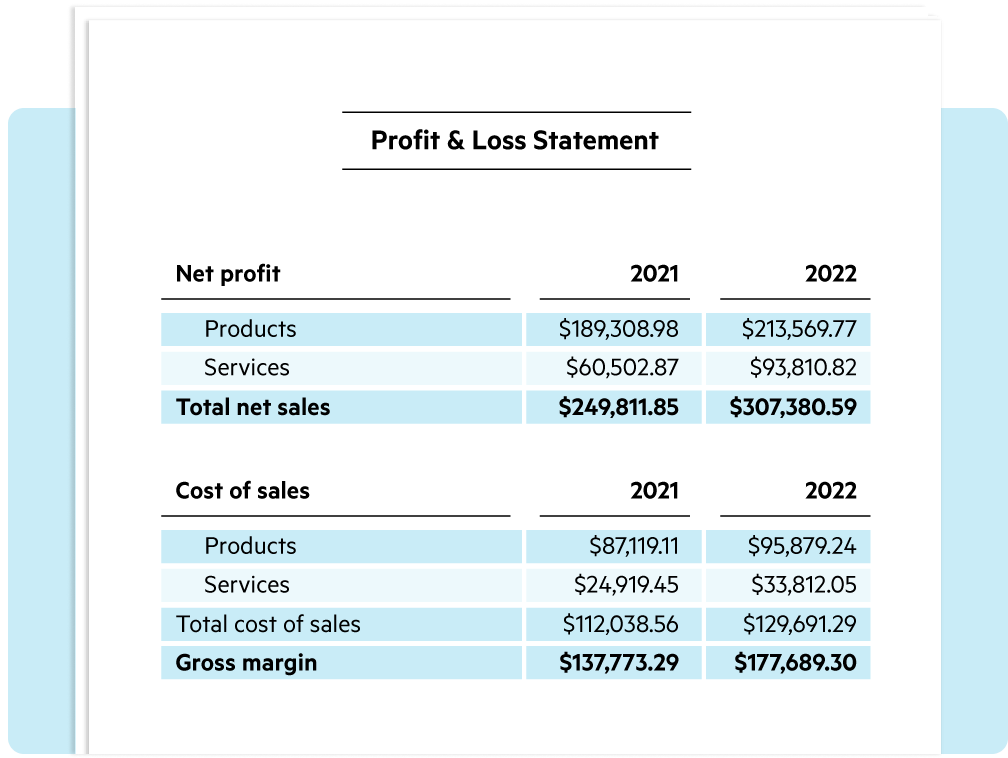
What is a Profit and Loss Statement?
A profit and loss statement, or P&L statement, is a financial document that helps you understand your business’s profitability over time. By contrasting your business income with your expenses, profit and loss statements help track your overall profits and identify periods of loss.
A P&L statement includes three primary sections: business expenses (money going out), revenue (money coming in), and net income (the difference between the two, commonly referred to as your profit margin).
Small businesses often use profit and loss statements to demonstrate their profitability to potential investors or when applying for a bank loan. P&L statements are one of the essential financial statements for businesses, along with balance sheets and cash flow statements . They are necessary for proving the status your business finances, and an important tool for you to assess whether your business is in the black (profitable) or the red (operating at a loss).

Profit and Loss Statement examples and templates
Creating a Profit and Loss statement for the first time can be overwhelming, but you can use this example to understand how a P&L statement should look.
Get a better idea about how to evaluate your business’s profitability with this P&L statement example.
Analyzing the financial performance of your business doesn’t have to be overly complicated. This simple profit and loss statement template offers a straightforward structure, including a reporting date range, a list of common line items, and built-in formulas to sum up revenue and expenses.
Just plug in your numbers for the defined reporting period and get an instant assessment of the financial health of your business.
When your business achieves a level of growth that necessitates a more in-depth profit and loss report, a multi-step P&L statement is likely more appropriate. This statement type separates operating revenue and expenses from non-operating revenue and expenses, providing an understanding of how the core activities of a business impact revenue and expenses, versus its non-essential activities.
A multi-step P&L statement enables you to calculate gross profit and operating income, which can be especially useful for external investors evaluating a business.
Lili prepares P&L statements for you
Lili’s Accounting Software automatically generates financial reports based on your transaction categorization, including Profit & Loss statements.
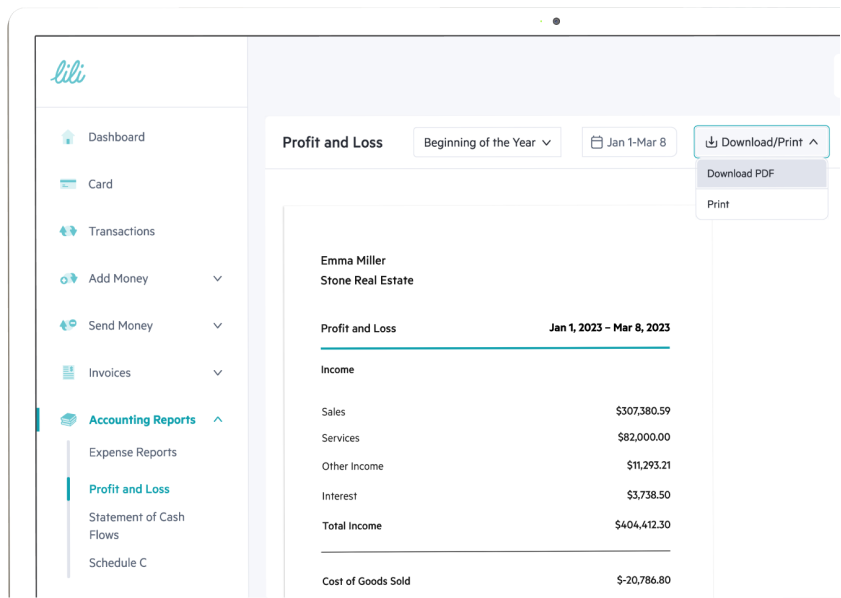
How to create a Profit and Loss Statement
Set your time range.
Determine the period of time for which you need to create a profit and loss statement. This can be anything from a month to a financial quarter or even a year.
Input profits and losses
Identify all revenue and expenses for the selected period of time, and input this information into your P&L statement template.
Customize for your business
All of our free profit and loss statement templates are customizable to your needs! Edit or remove line items that are not relevant to your business, or add in lines as you go to fit with unique revenue sources and business expenses.
Check Excel formulas
Don’t assume the formulas are acting as they should! Double check formulas for fields such as Total Expenses and Net Profit, making sure the calculations are filling correctly.
Save your results
Save a copy of this P&L statement for your business records, or convert it to a PDF and share with the appropriate parties (e.g. an investor or lender).
What is the purpose of a P&L Statement?
A profit and loss statement is helpful for your own understanding of your business’s financial health. It is a quick way to check whether your business is operating at a profit or a loss, helps you review expenses to understand where you can increase spend (or where you need to cut costs), and helps you check in on the quality of your profit margin.
P&L statements are also a helpful way to outline your business’s current and projected profitability to any outside entities that may require it. Investors will want to see that you are operating at a profit, or have a pathway to future profitability. Lenders will need to see where your business is at financially right now, and how you plan to improve in the future. Business finances naturally will ebb and flow, and a profit and loss statement can demonstrate how these changes pan out over time.

Profit & Loss Statement Format
A profit and loss statement includes a number of elements that are relevant to your business finances, including:

Net sales/Revenue
Your total business revenue for the given period of time. This may look different depending on your accounting processes and the type of business you are running.
Cost of Goods Sold (COGS)
Expenses associated with producing the products or services you provide, such as raw materials, employee wages, and shipping expenses.
Business Expenses
Operating expenses related to selling and marketing, and administrative expenses associated with your business that are not directly related to the production of goods or services. Examples of such expenses include rent, advertising, and software subscriptions.
Your pre-tax income.
Earnings per Share (EPS)
Net income divided by the number of shares for the given period of time.
Depreciation
Value lost by depreciating assets such as equipment, inventory, vehicles, and property during the specified period of time.
Earnings Before Interest, Tax, Depreciation, and Amortization (EBITDA)
Earnings for the selected period of time after subtracting all internal costs, but before subtracting external costs (interest, tax, depreciation, and amortization).
Frequently asked questions
Yes, you can create your own profit and loss statement! A P&L statement can be manually prepared either by starting from scratch, or by using a statement template, like the downloadable statements templates available above .
Yes, an income statement is the same as a Profit and Loss statement. “Profit and Loss statement” and “income statement” are often used interchangeably , as they are both financial statements whose purpose is to summarize the financial performance of a business during a specific financial period in order to determine its profitability.
To read and understand your profit and loss statement, you should be intimately familiar with the primary metrics of your business, including revenue and expenses. However, in order to understand a P&L statement, you need to think strategically in order to put the numbers into the proper context.
Consider how a potential investor or lender would view your profits and losses, and use the following questions as guiding points to help you evaluate the financial state of your business:
- Are your revenue streams aligned with your business goals?
- Are your expenses essential to your business?
- How is your profit margin compared to other businesses in your industry?
- If this isn’t your first P&L statement for your business, how does it compare to previous statements?
Streamline your business accounting with Lili
Simplify your bookkeeping with instant transaction categorization, and gain clarity about your business’s financial status with income & expense insights and auto-generated financial reports. Make it easier to balance your books with Lili’s Accounting Software.
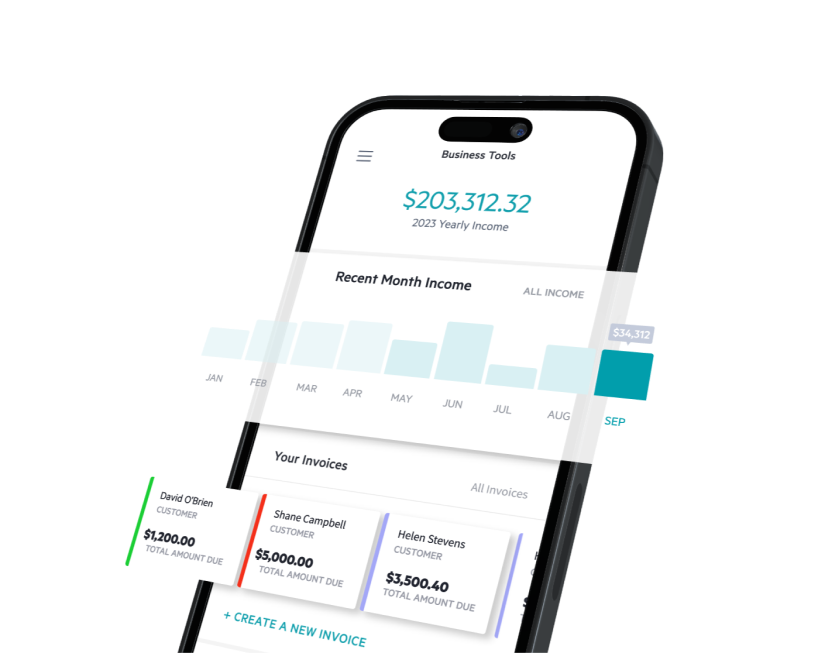
Related Financial Report Guides
Fill in some basic personal information.
Share a few details including business type, EIN and industry.
Choose the account plan that best fits your business.
Email Our Support Team or Call Us
Mon – Friday, 9am – 8pm EST
Lili is a financial technology company, not a bank. Banking services are provided by Choice Financial Group, Member FDIC, or Sunrise Banks, N.A., Member FDIC. The Lili Visa® Debit Card is issued by Choice Financial Group, Member FDIC, or Sunrise Banks, N.A., Member FDIC, pursuant to a license from Visa U.S.A., Inc. Please see the back of your Card for its issuing bank. The Card may be used everywhere Visa debit cards are accepted.
Wire Transfer service provided by Column Bank N.A., Member FDIC. All wires are subject to acceptance criteria and risk-based review and may be rejected at the sole discretion of Column Bank N. A. or Lili App Inc.
1 Available to Lili Pro, Lili Smart, and Lili Premium account holders only, applicable monthly account fee applies. For details, please refer to our Choice Financial Group Account Agreement if your Lili business deposit account was opened with Choice Financial Group, Member FDIC, or Sunrise Banks Account Agreement if your Lili business deposit account was opened with Sunrise Banks, N.A., Member FDIC.
2 Available to Lili Smart and Lili Premium account holders only, applicable monthly account fee applies. For details, please refer to our Choice Financial Group Account Agreement if your Lili business deposit account was opened with Choice Financial Group, Member FDIC, or Sunrise Banks Account Agreement if your Lili business deposit account was opened with Sunrise Banks, N.A., Member FDIC.
3 The Annual Percentage Yield (“APY”) for the Lili Savings Account is variable and may change at any time. The disclosed APY is effective as of September 1, 2023. Must have at least $0.01 in savings to earn interest. The APY applies to balances of up to and including $100,000. Any portions of a balance over $100,000 will not earn interest or have a yield. Available to Lili Pro, Lili Smart, and Lili Premium account holders only.
4 BalanceUp is a discretionary overdraft program for debit card purchases only, offered for Lili Pro, Lili Smart, and Lili Premium Account holders. You must meet eligibility requirements and enroll in the program. Once enrolled, your Account must remain in good standing with a deposit and spending history that meets our discretionary requirements to maintain access to the feature. BalanceUp overdraft limits of $20-$200 are provided at our sole discretion, and may be revoked any time, with or without notice.
5 Early access to ACH transfer funds depends on the timing of payer’s submission of transfers. Lili will generally post these transfers on the day they are received which can be up to 2 days earlier than the payer’s scheduled payment date.
6 Up to $1,000 per 24 hours period and a maximum of $9,000 per month. Some locations have lower limits and retailer fees may vary ($4.95 max). Note that Lili does not charge transaction fees.
7 Lili AI and other reports related to income and expense provided by Lili can be used to assist with your accounting. Final categorization of income and expenses for tax purposes is your responsibility. Lili is not a tax preparer and does not provide tax, legal or accounting advice. You should consult your own tax, legal and accounting advisors regarding your specific situation.
8 Lili does not charge debit card fees related to foreign transactions, in-network ATM usage, or card inactivity, or require a minimum balance. The Lili Visa® Debit Card is included in all account plans, and remains fee-free with the Lili Basic plan. Applicable monthly account fee applies for the Lili Pro, Lili Smart, and Lili Premium plans. For details, please refer to our Choice Financial Group Account Agreement if your Lili business deposit account was opened with Choice Financial Group, Member FDIC, or Sunrise Banks Account Agreement if your Lili business deposit account was opened with Sunrise Banks, N.A., Member FDIC.
9 The Mail a Check, Outgoing Wire Transfers and Invite Your Accountant features are only available for Lili business deposit accounts opened through Sunrise Banks, N.A., Member FDIC.
© 2024 Lili App Inc. All Rights Reserved.
Inc. Best in Business Early-Rate Deadline Friday, August 16! Apply Today!
- Newsletters
- Best Industries
- Business Plans
- Home-Based Business
- The UPS Store
- Customer Service
- Black in Business
- Your Next Move
- Female Founders
- Best Workplaces
- Company Culture
- Public Speaking
- HR/Benefits
- Productivity
- All the Hats
- Digital Transformation
- Artificial Intelligence
- Bringing Innovation to Market
- Cloud Computing
- Social Media
- Data Detectives
- Exit Interview
- Bootstrapping
- Crowdfunding
- Venture Capital
- Business Models
- Personal Finance
- Founder-Friendly Investors
- Upcoming Events
- Inc. 5000 Vision Conference
- Become a Sponsor
- Cox Business
- Verizon Business
- Branded Content
- Apply Inc. 5000 US
Inc. Premium

How to Write the Financial Section of a Business Plan
An outline of your company's growth strategy is essential to a business plan, but it just isn't complete without the numbers to back it up. here's some advice on how to include things like a sales forecast, expense budget, and cash-flow statement..

A business plan is all conceptual until you start filling in the numbers and terms. The sections about your marketing plan and strategy are interesting to read, but they don't mean a thing if you can't justify your business with good figures on the bottom line. You do this in a distinct section of your business plan for financial forecasts and statements. The financial section of a business plan is one of the most essential components of the plan, as you will need it if you have any hope of winning over investors or obtaining a bank loan. Even if you don't need financing, you should compile a financial forecast in order to simply be successful in steering your business. "This is what will tell you whether the business will be viable or whether you are wasting your time and/or money," says Linda Pinson, author of Automate Your Business Plan for Windows (Out of Your Mind 2008) and Anatomy of a Business Plan (Out of Your Mind 2008), who runs a publishing and software business Out of Your Mind and Into the Marketplace . "In many instances, it will tell you that you should not be going into this business." The following will cover what the financial section of a business plan is, what it should include, and how you should use it to not only win financing but to better manage your business.
Dig Deeper: Generating an Accurate Sales Forecast
Editor's Note: Looking for Business Loans for your company? If you would like information to help you choose the one that's right for you, use the questionnaire below to have our partner, BuyerZone, provide you with information for free:
How to Write the Financial Section of a Business Plan: The Purpose of the Financial Section Let's start by explaining what the financial section of a business plan is not. Realize that the financial section is not the same as accounting. Many people get confused about this because the financial projections that you include--profit and loss, balance sheet, and cash flow--look similar to accounting statements your business generates. But accounting looks back in time, starting today and taking a historical view. Business planning or forecasting is a forward-looking view, starting today and going into the future. "You don't do financials in a business plan the same way you calculate the details in your accounting reports," says Tim Berry, president and founder of Palo Alto Software, who blogs at Bplans.com and is writing a book, The Plan-As-You-Go Business Plan. "It's not tax reporting. It's an elaborate educated guess." What this means, says Berry, is that you summarize and aggregate more than you might with accounting, which deals more in detail. "You don't have to imagine all future asset purchases with hypothetical dates and hypothetical depreciation schedules to estimate future depreciation," he says. "You can just guess based on past results. And you don't spend a lot of time on minute details in a financial forecast that depends on an educated guess for sales." The purpose of the financial section of a business plan is two-fold. You're going to need it if you are seeking investment from venture capitalists, angel investors, or even smart family members. They are going to want to see numbers that say your business will grow--and quickly--and that there is an exit strategy for them on the horizon, during which they can make a profit. Any bank or lender will also ask to see these numbers as well to make sure you can repay your loan. But the most important reason to compile this financial forecast is for your own benefit, so you understand how you project your business will do. "This is an ongoing, living document. It should be a guide to running your business," Pinson says. "And at any particular time you feel you need funding or financing, then you are prepared to go with your documents." If there is a rule of thumb when filling in the numbers in the financial section of your business plan, it's this: Be realistic. "There is a tremendous problem with the hockey-stick forecast" that projects growth as steady until it shoots up like the end of a hockey stick, Berry says. "They really aren't credible." Berry, who acts as an angel investor with the Willamette Angel Conference, says that while a startling growth trajectory is something that would-be investors would love to see, it's most often not a believable growth forecast. "Everyone wants to get involved in the next Google or Twitter, but every plan seems to have this hockey stick forecast," he says. "Sales are going along flat, but six months from now there is a huge turn and everything gets amazing, assuming they get the investors' money." The way you come up a credible financial section for your business plan is to demonstrate that it's realistic. One way, Berry says, is to break the figures into components, by sales channel or target market segment, and provide realistic estimates for sales and revenue. "It's not exactly data, because you're still guessing the future. But if you break the guess into component guesses and look at each one individually, it somehow feels better," Berry says. "Nobody wins by overly optimistic or overly pessimistic forecasts."
Dig Deeper: What Angel Investors Look For
How to Write the Financial Section of a Business Plan: The Components of a Financial Section
A financial forecast isn't necessarily compiled in sequence. And you most likely won't present it in the final document in the same sequence you compile the figures and documents. Berry says that it's typical to start in one place and jump back and forth. For example, what you see in the cash-flow plan might mean going back to change estimates for sales and expenses. Still, he says that it's easier to explain in sequence, as long as you understand that you don't start at step one and go to step six without looking back--a lot--in between.
- Start with a sales forecast. Set up a spreadsheet projecting your sales over the course of three years. Set up different sections for different lines of sales and columns for every month for the first year and either on a monthly or quarterly basis for the second and third years. "Ideally you want to project in spreadsheet blocks that include one block for unit sales, one block for pricing, a third block that multiplies units times price to calculate sales, a fourth block that has unit costs, and a fifth that multiplies units times unit cost to calculate cost of sales (also called COGS or direct costs)," Berry says. "Why do you want cost of sales in a sales forecast? Because you want to calculate gross margin. Gross margin is sales less cost of sales, and it's a useful number for comparing with different standard industry ratios." If it's a new product or a new line of business, you have to make an educated guess. The best way to do that, Berry says, is to look at past results.
- Create an expenses budget. You're going to need to understand how much it's going to cost you to actually make the sales you have forecast. Berry likes to differentiate between fixed costs (i.e., rent and payroll) and variable costs (i.e., most advertising and promotional expenses), because it's a good thing for a business to know. "Lower fixed costs mean less risk, which might be theoretical in business schools but are very concrete when you have rent and payroll checks to sign," Berry says. "Most of your variable costs are in those direct costs that belong in your sales forecast, but there are also some variable expenses, like ads and rebates and such." Once again, this is a forecast, not accounting, and you're going to have to estimate things like interest and taxes. Berry recommends you go with simple math. He says multiply estimated profits times your best-guess tax percentage rate to estimate taxes. And then multiply your estimated debts balance times an estimated interest rate to estimate interest.
- Develop a cash-flow statement. This is the statement that shows physical dollars moving in and out of the business. "Cash flow is king," Pinson says. You base this partly on your sales forecasts, balance sheet items, and other assumptions. If you are operating an existing business, you should have historical documents, such as profit and loss statements and balance sheets from years past to base these forecasts on. If you are starting a new business and do not have these historical financial statements, you start by projecting a cash-flow statement broken down into 12 months. Pinson says that it's important to understand when compiling this cash-flow projection that you need to choose a realistic ratio for how many of your invoices will be paid in cash, 30 days, 60 days, 90 days and so on. You don't want to be surprised that you only collect 80 percent of your invoices in the first 30 days when you are counting on 100 percent to pay your expenses, she says. Some business planning software programs will have these formulas built in to help you make these projections.
- Income projections. This is your pro forma profit and loss statement, detailing forecasts for your business for the coming three years. Use the numbers that you put in your sales forecast, expense projections, and cash flow statement. "Sales, lest cost of sales, is gross margin," Berry says. "Gross margin, less expenses, interest, and taxes, is net profit."
- Deal with assets and liabilities. You also need a projected balance sheet. You have to deal with assets and liabilities that aren't in the profits and loss statement and project the net worth of your business at the end of the fiscal year. Some of those are obvious and affect you at only the beginning, like startup assets. A lot are not obvious. "Interest is in the profit and loss, but repayment of principle isn't," Berry says. "Taking out a loan, giving out a loan, and inventory show up only in assets--until you pay for them." So the way to compile this is to start with assets, and estimate what you'll have on hand, month by month for cash, accounts receivable (money owed to you), inventory if you have it, and substantial assets like land, buildings, and equipment. Then figure out what you have as liabilities--meaning debts. That's money you owe because you haven't paid bills (which is called accounts payable) and the debts you have because of outstanding loans.
- Breakeven analysis. The breakeven point, Pinson says, is when your business's expenses match your sales or service volume. The three-year income projection will enable you to undertake this analysis. "If your business is viable, at a certain period of time your overall revenue will exceed your overall expenses, including interest." This is an important analysis for potential investors, who want to know that they are investing in a fast-growing business with an exit strategy.
Dig Deeper: How to Price Business Services
How to Write the Financial Section of a Business Plan: How to Use the Financial Section One of the biggest mistakes business people make is to look at their business plan, and particularly the financial section, only once a year. "I like to quote former President Dwight D. Eisenhower," says Berry. "'The plan is useless, but planning is essential.' What people do wrong is focus on the plan, and once the plan is done, it's forgotten. It's really a shame, because they could have used it as a tool for managing the company." In fact, Berry recommends that business executives sit down with the business plan once a month and fill in the actual numbers in the profit and loss statement and compare those numbers with projections. And then use those comparisons to revise projections in the future. Pinson also recommends that you undertake a financial statement analysis to develop a study of relationships and compare items in your financial statements, compare financial statements over time, and even compare your statements to those of other businesses. Part of this is a ratio analysis. She recommends you do some homework and find out some of the prevailing ratios used in your industry for liquidity analysis, profitability analysis, and debt and compare those standard ratios with your own. "This is all for your benefit," she says. "That's what financial statements are for. You should be utilizing your financial statements to measure your business against what you did in prior years or to measure your business against another business like yours." If you are using your business plan to attract investment or get a loan, you may also include a business financial history as part of the financial section. This is a summary of your business from its start to the present. Sometimes a bank might have a section like this on a loan application. If you are seeking a loan, you may need to add supplementary documents to the financial section, such as the owner's financial statements, listing assets and liabilities. All of the various calculations you need to assemble the financial section of a business plan are a good reason to look for business planning software, so you can have this on your computer and make sure you get this right. Software programs also let you use some of your projections in the financial section to create pie charts or bar graphs that you can use elsewhere in your business plan to highlight your financials, your sales history, or your projected income over three years. "It's a pretty well-known fact that if you are going to seek equity investment from venture capitalists or angel investors," Pinson says, "they do like visuals."
Dig Deeper: How to Protect Your Margins in a Downturn
Related Links: Making It All Add Up: The Financial Section of a Business Plan One of the major benefits of creating a business plan is that it forces entrepreneurs to confront their company's finances squarely. Persuasive Projections You can avoid some of the most common mistakes by following this list of dos and don'ts. Making Your Financials Add Up No business plan is complete until it contains a set of financial projections that are not only inspiring but also logical and defensible. How many years should my financial projections cover for a new business? Some guidelines on what to include. Recommended Resources: Bplans.com More than 100 free sample business plans, plus articles, tips, and tools for developing your plan. Planning, Startups, Stories: Basic Business Numbers An online video in author Tim Berry's blog, outlining what you really need to know about basic business numbers. Out of Your Mind and Into the Marketplace Linda Pinson's business selling books and software for business planning. Palo Alto Software Business-planning tools and information from the maker of the Business Plan Pro software. U.S. Small Business Administration Government-sponsored website aiding small and midsize businesses. Financial Statement Section of a Business Plan for Start-Ups A guide to writing the financial section of a business plan developed by SCORE of northeastern Massachusetts.
Editorial Disclosure: Inc. writes about products and services in this and other articles. These articles are editorially independent - that means editors and reporters research and write on these products free of any influence of any marketing or sales departments. In other words, no one is telling our reporters or editors what to write or to include any particular positive or negative information about these products or services in the article. The article's content is entirely at the discretion of the reporter and editor. You will notice, however, that sometimes we include links to these products and services in the articles. When readers click on these links, and buy these products or services, Inc may be compensated. This e-commerce based advertising model - like every other ad on our article pages - has no impact on our editorial coverage. Reporters and editors don't add those links, nor will they manage them. This advertising model, like others you see on Inc, supports the independent journalism you find on this site.
The Daily Digest for Entrepreneurs and Business Leaders
Privacy Policy
Everything that you need to know to start your own business. From business ideas to researching the competition.
Practical and real-world advice on how to run your business — from managing employees to keeping the books
Our best expert advice on how to grow your business — from attracting new customers to keeping existing customers happy and having the capital to do it.
Entrepreneurs and industry leaders share their best advice on how to take your company to the next level.
- Business Ideas
- Human Resources
- Business Financing
- Growth Studio
- Ask the Board
Looking for your local chamber?
Interested in partnering with us?
Start » startup, business plan financials: 3 statements to include.
The finance section of your business plan is essential to securing investors and determining whether your idea is even viable. Here's what to include.

If your business plan is the blueprint of how to run your company, the financials section is the key to making it happen. The finance section of your business plan is essential to determining whether your idea is even viable in the long term. It’s also necessary to convince investors of this viability and subsequently secure the type and amount of funding you need. Here’s what to include in your business plan financials.
[Read: How to Write a One-Page Business Plan ]
What are business plan financials?
Business plan financials is the section of your business plan that outlines your past, current and projected financial state. This section includes all the numbers and hard data you’ll need to plan for your business’s future, and to make your case to potential investors. You will need to include supporting financial documents and any funding requests in this part of your business plan.
Business plan financials are vital because they allow you to budget for existing or future expenses, as well as forecast your business’s future finances. A strongly written finance section also helps you obtain necessary funding from investors, allowing you to grow your business.
Sections to include in your business plan financials
Here are the three statements to include in the finance section of your business plan:
Profit and loss statement
A profit and loss statement , also known as an income statement, identifies your business’s revenue (profit) and expenses (loss). This document describes your company’s overall financial health in a given time period. While profit and loss statements are typically prepared quarterly, you will need to do so at least annually before filing your business tax return with the IRS.
Common items to include on a profit and loss statement :
- Revenue: total sales and refunds, including any money gained from selling property or equipment.
- Expenditures: total expenses.
- Cost of goods sold (COGS): the cost of making products, including materials and time.
- Gross margin: revenue minus COGS.
- Operational expenditures (OPEX): the cost of running your business, including paying employees, rent, equipment and travel expenses.
- Depreciation: any loss of value over time, such as with equipment.
- Earnings before tax (EBT): revenue minus COGS, OPEX, interest, loan payments and depreciation.
- Profit: revenue minus all of your expenses.
Businesses that have not yet started should provide projected income statements in their financials section. Currently operational businesses should include past and present income statements, in addition to any future projections.
[Read: Top Small Business Planning Strategies ]
A strongly written finance section also helps you obtain necessary funding from investors, allowing you to grow your business.
Balance sheet
A balance sheet provides a snapshot of your company’s finances, allowing you to keep track of earnings and expenses. It includes what your business owns (assets) versus what it owes (liabilities), as well as how much your business is currently worth (equity).
On the assets side of your balance sheet, you will have three subsections: current assets, fixed assets and other assets. Current assets include cash or its equivalent value, while fixed assets refer to long-term investments like equipment or buildings. Any assets that do not fall within these categories, such as patents and copyrights, can be classified as other assets.
On the liabilities side of your balance sheet, include a total of what your business owes. These can be broken down into two parts: current liabilities (amounts to be paid within a year) and long-term liabilities (amounts due for longer than a year, including mortgages and employee benefits).
Once you’ve calculated your assets and liabilities, you can determine your business’s net worth, also known as equity. This can be calculated by subtracting what you owe from what you own, or assets minus liabilities.
Cash flow statement
A cash flow statement shows the exact amount of money coming into your business (inflow) and going out of it (outflow). Each cost incurred or amount earned should be documented on its own line, and categorized into one of the following three categories: operating activities, investment activities and financing activities. These three categories can all have inflow and outflow activities.
Operating activities involve any ongoing expenses necessary for day-to-day operations; these are likely to make up the majority of your cash flow statement. Investment activities, on the other hand, cover any long-term payments that are needed to start and run your business. Finally, financing activities include the money you’ve used to fund your business venture, including transactions with creditors or funders.
CO— aims to bring you inspiration from leading respected experts. However, before making any business decision, you should consult a professional who can advise you based on your individual situation.
Follow us on Instagram for more expert tips & business owners’ stories.
CO—is committed to helping you start, run and grow your small business. Learn more about the benefits of small business membership in the U.S. Chamber of Commerce, here .
Subscribe to our newsletter, Midnight Oil
Expert business advice, news, and trends, delivered weekly
By signing up you agree to the CO— Privacy Policy. You can opt out anytime.
More tips for your startup
How to choose a legal entity for your startup, 5 steps to use social media to launch your business, 5 alternatives to writing a traditional business plan.
By continuing on our website, you agree to our use of cookies for statistical and personalisation purposes. Know More
Welcome to CO—
Designed for business owners, CO— is a site that connects like minds and delivers actionable insights for next-level growth.
U.S. Chamber of Commerce 1615 H Street, NW Washington, DC 20062
Social links
Looking for local chamber, stay in touch.
Free Profit and Loss Templates
By Andy Marker | March 26, 2018
- Share on Facebook
- Share on LinkedIn
Link copied
We’ve compiled the most useful collection of free profit and loss (P&L) templates for company owners, corporate officers, accountants, and shareholders. Plan and track your organization’s P&L with these free, easy-to-use templates.
Included on this page, you’ll find a simple profit and loss template , a small business profit and loss template , a self-employed profit and loss template , a printable profit and loss template , and a restaurant profit and loss template , among others. Plus, find tips for using these P&L templates .
Simple Profit and Loss Statement Template
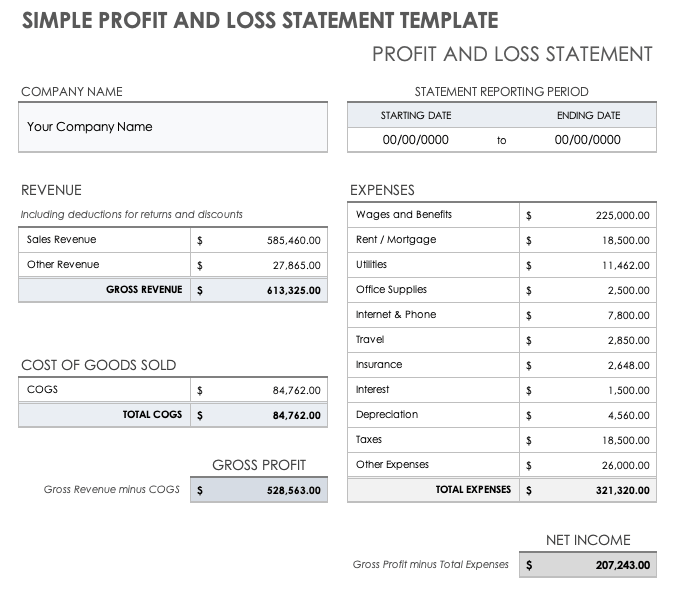
Download Simple Profit and Loss Statement Microsoft Excel | Microsoft Word | Adobe PDF
Use this simple P&L statement template to calculate your organization’s total revenue compared to your costs and expenses. This fully customizable template prompts you to note your Statement Reporting Period date range, enter revenues (including any deductions for returns and discounts) and cost of goods sold (COGS), to determine your gross profit. Enter your expenses to calculate your total expenses, and to reach your net income figure.
For more finance-reporting resources and templates, read our article on business plan financial templates .
Small Business Profit and Loss Statement Template
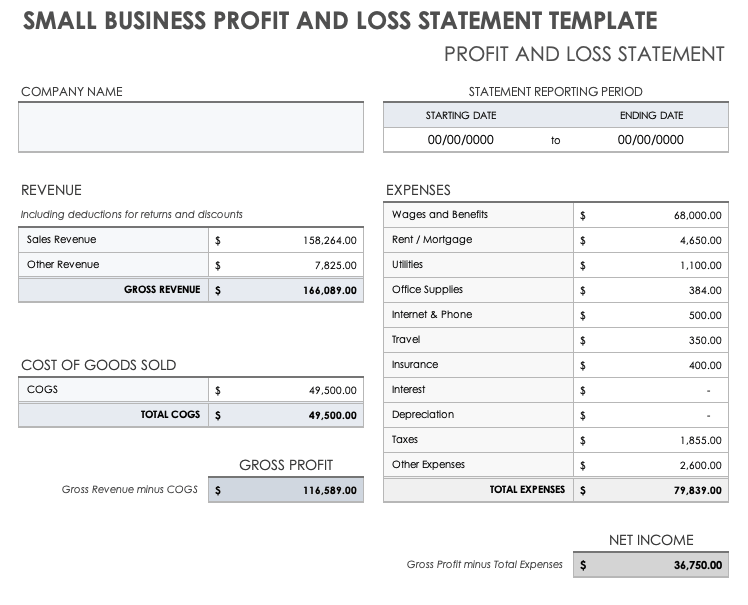
Download Small Business Profit and Loss Template Microsoft Excel | Adobe PDF | Google Sheets
Use this simple template if the categories under income and expenses don’t need to be broken out. This template can be used by service, retail, and B2B organizations. The income section includes space to show income and to deduct the cost of goods sold. The expenses section includes common categories, such as wages and benefits, insurance, and taxes. To use this template for multiple periods (e.g., six months or three years), save a copy for each time period.
Read our article on free small business profit and loss templates to find additional resources and get the most out of your P&L statements.
Self-Employed Profit and Loss Template
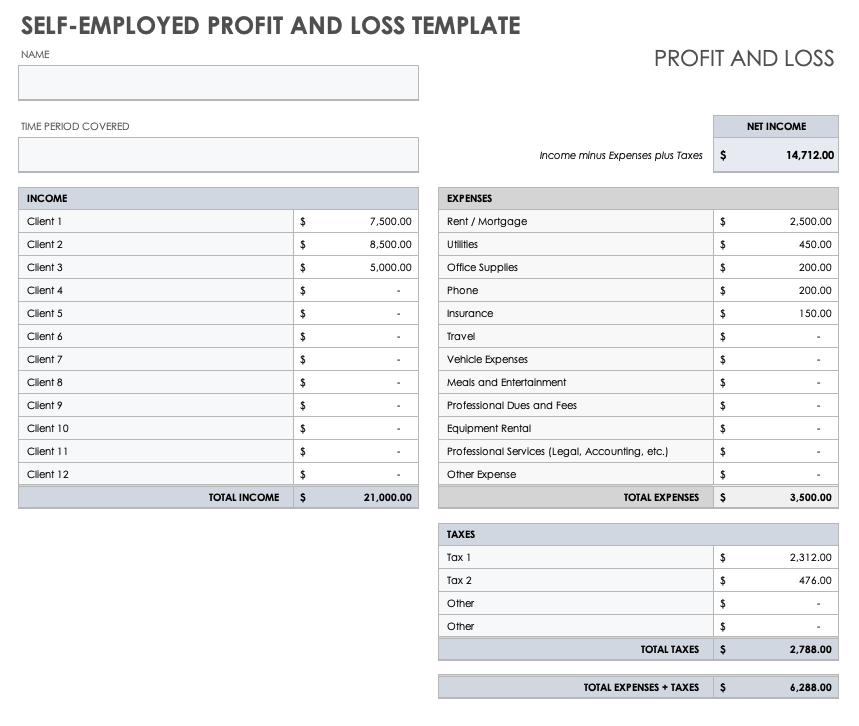
Download Self-Employed Profit and Loss Template Microsoft Excel | Adobe PDF | Google Sheets
Self-employed people and freelancers have unique needs. This self-employed profit and loss template takes these requirements into account by breaking out income by client and by using expense categories that apply to people who work for themselves.
Restaurant Profit and Loss Template
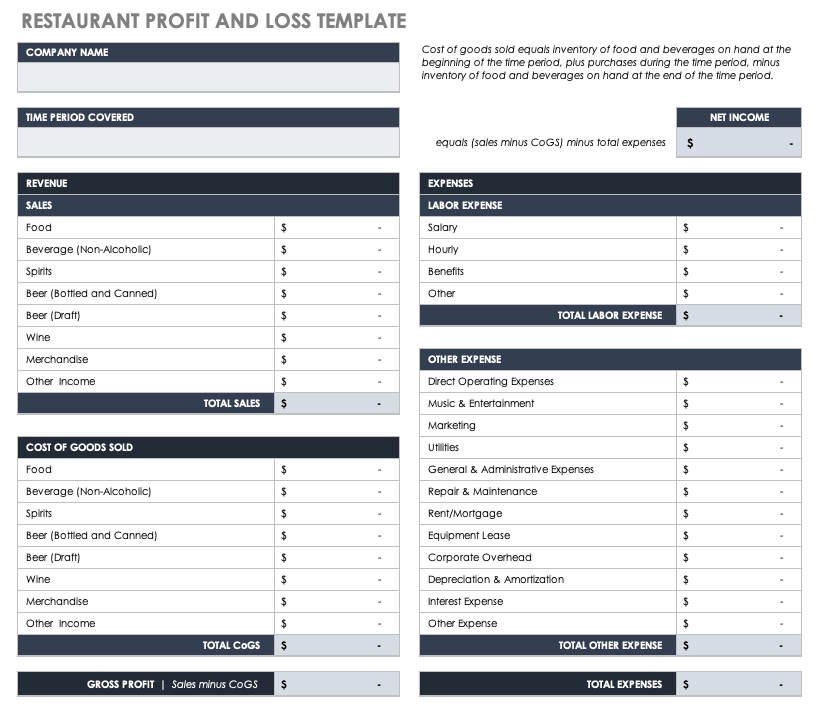
Download Restaurant Profit and Loss Template — Microsoft Excel
Food service businesses have to keep track of their food and beverage inventories. This template has entries for different types of inventory — including multiple beverage categories, such as draft beer, canned and bottled beer, wine, spirits, and non-alcoholic beer — in both the sales and cost of goods sold sections.
Printable Profit and Loss Statement Template
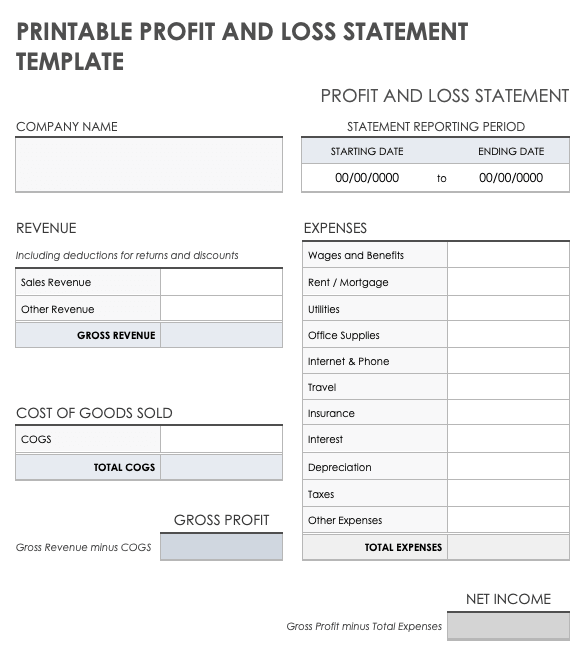
Download Printable Profit and Loss Statement Template Microsoft Word | Adobe PDF | Google Docs
This one-page P&L template provides a print-friendly solution for those looking to compare their total revenues to their total costs and expenses. Use his straightforward template to determine whether your net income puts you in the red or black, and whether you need to increase your profits by increasing your revenues or reducing expenses.
Monthly Profit and Loss Template
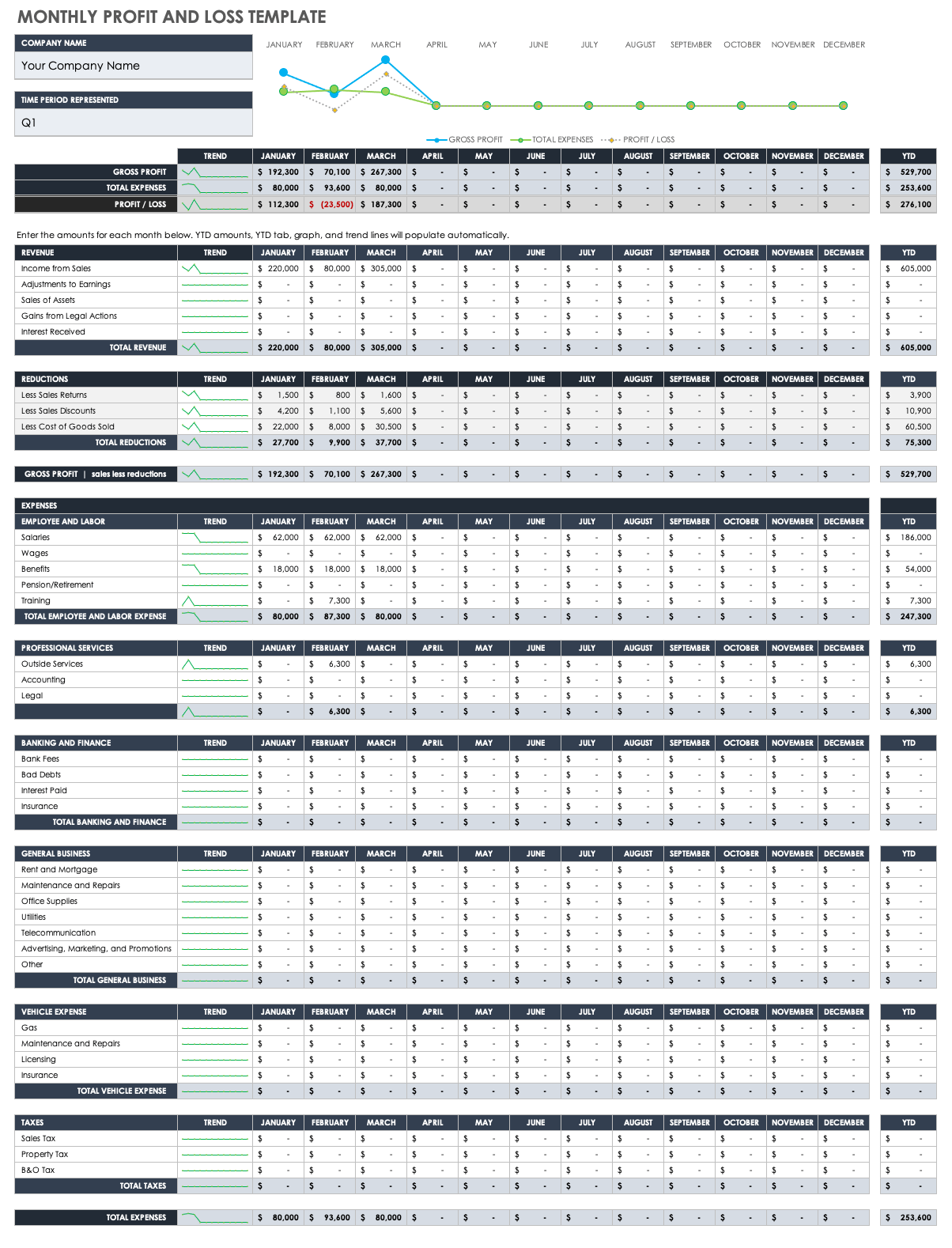
Download Monthly Profit and Loss Template — Microsoft Excel
Use this template to create a P&L statement that tracks your month-by-month and year-to-date (YTD) costs and expenses compared to your revenue. Enter your revenue figures, reductions, expenses, professional services (if applicable), banking and finance information, general business costs, and taxes to determine if your total revenue exceeds your costs and expenses. A month-by-month bar chart indicates your P&L trend by mapping how your gross profit relates to your total expenses over a series of months.
Quarterly Profit and Loss Statement Template
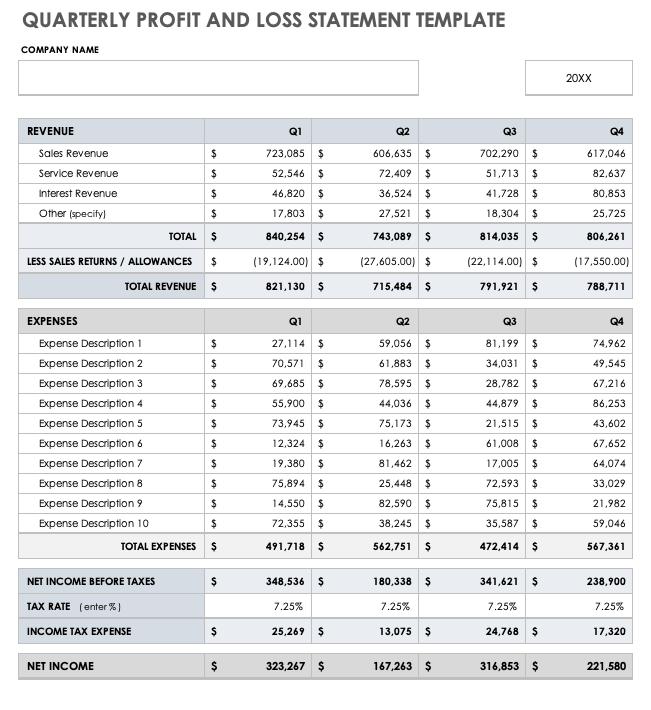
Download Quarterly Profit and Loss Statement — Microsoft Excel
Use this three-month P&L statement template to record your quarterly income and expenses. This template is a perfect solution for companies that need to provide quarterly P&L updates, and includes quarter-by-quarter columns, so that stakeholders can review your organization’s net income in smaller time increments.
Annual Profit and Loss Sample Template
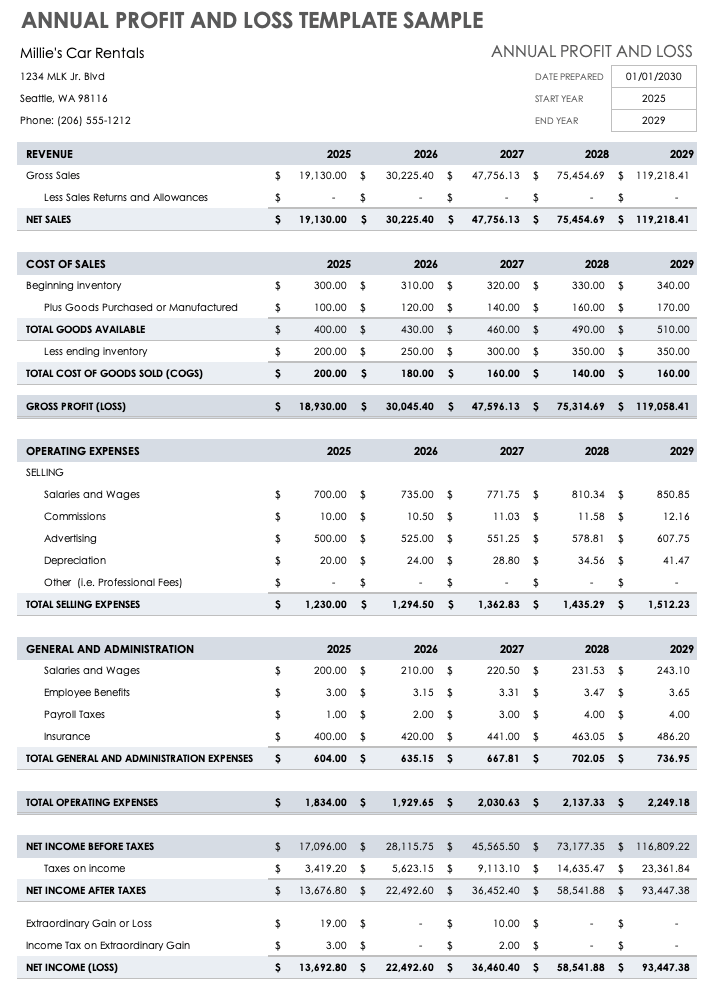
Download Annual Profit and Loss Template Sample — Microsoft Excel
Measure your YTD and year-over-year profits and losses by comparing your total revenue to your total expenses and costs. Enter annual revenue, cost of sales, operating expenses, general and administrative costs, and taxes to determine your net income. The template provides annual insight into your P&L, as well as a five-year outlook on your profit and loss trends.
Weekly Profit and Loss Template
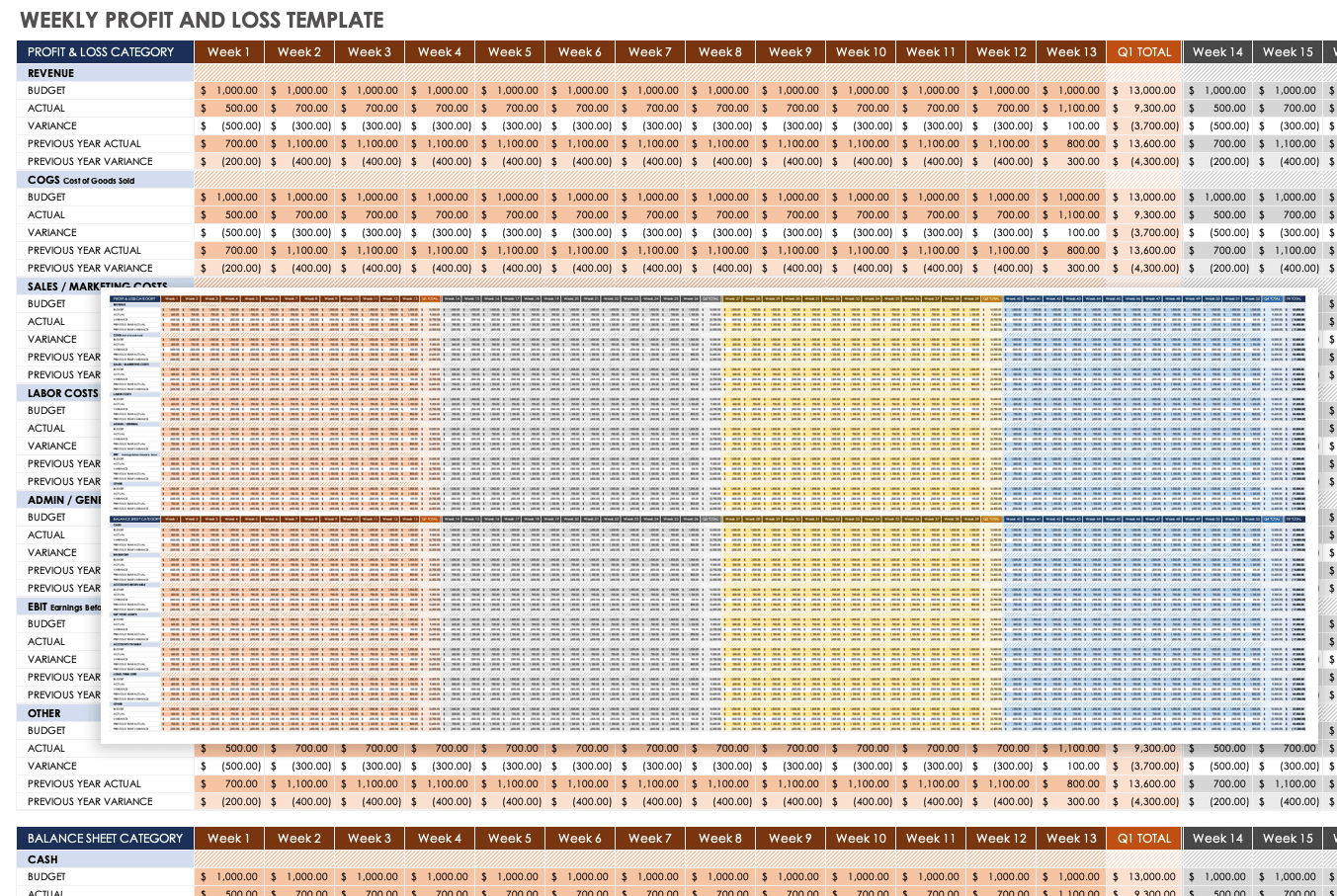
Download Weekly Profit and Loss Template Microsoft Excel | Google Sheets
Track your week-by-week budgeted revenue versus your actual revenue with this weekly profit and loss template. The template’s detailed Profit and Loss Category sections include revenue, COGS, sales and marketing costs, labor and administrative costs, and earnings before interest and taxes (EBIT). The template’s Balance Sheet Category sections includes cash, inventory, accounts receivable, net fixed assets, accounts payable, long-term debt, and other factors. Week-by-week columns provide you with more detailed insight into your P&L, and whether you need to reduce costs or increase revenue to boost your profits.
Read our article on free small business budget templates to find additional budgeting resources and to improve financial tracking and management.
Retail Profit and Loss Template
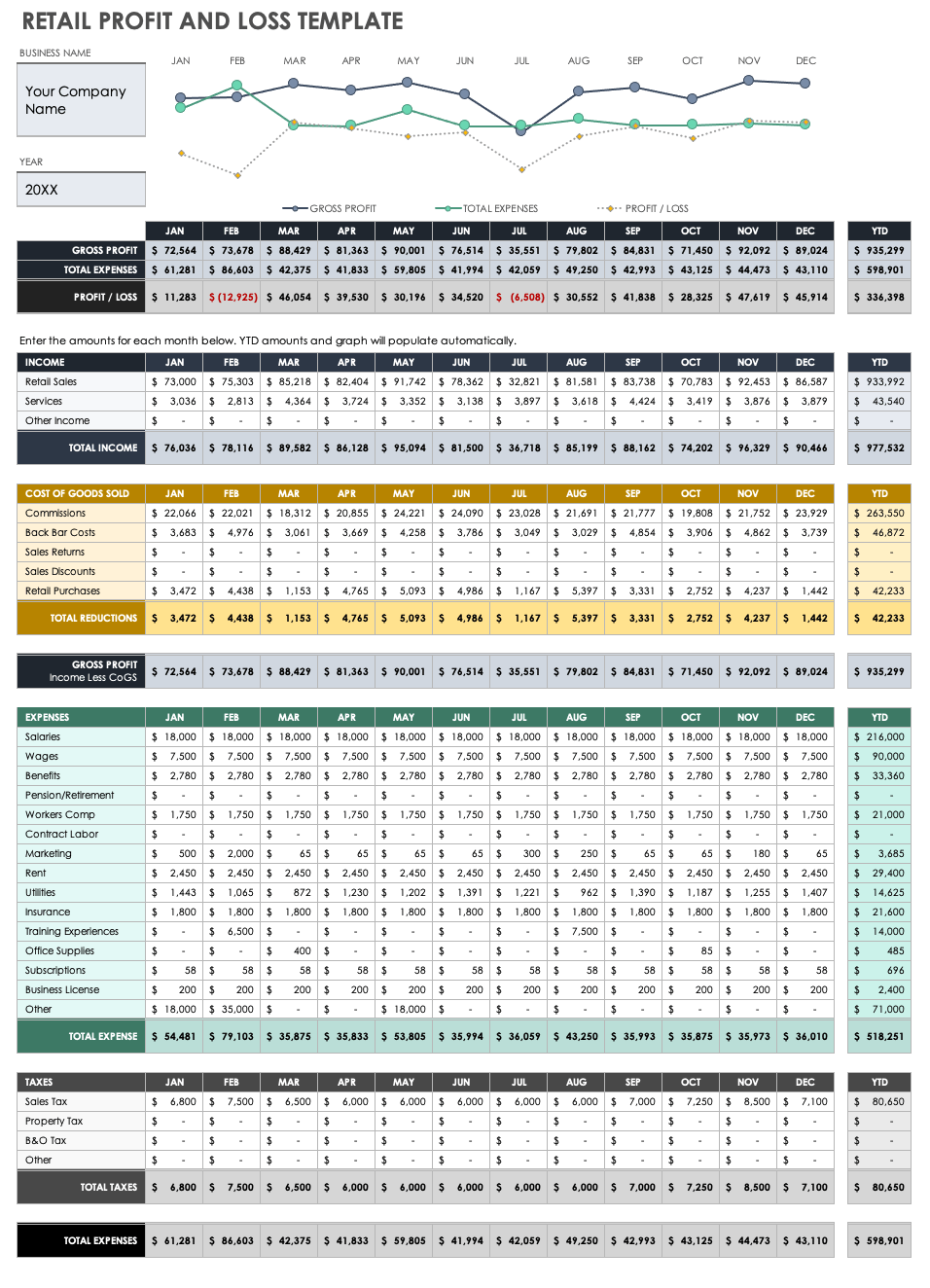
Download Retail Profit and Loss Template Microsoft Excel | Google Sheets
Use this visually dynamic retail P&L template to determine your store’s profits or losses over any customized period of time. Enter income and expense figures, and the dashboard-style bar chart will illustrate your gross profit, total expenses, and actual P&L, while comparing your profits versus expenses. Use the detailed Costs of Goods Sold and Taxes sections to further account for every figure related to your P&L, as well as the overall fiscal health of your organization.
Construction Profit and Loss Template
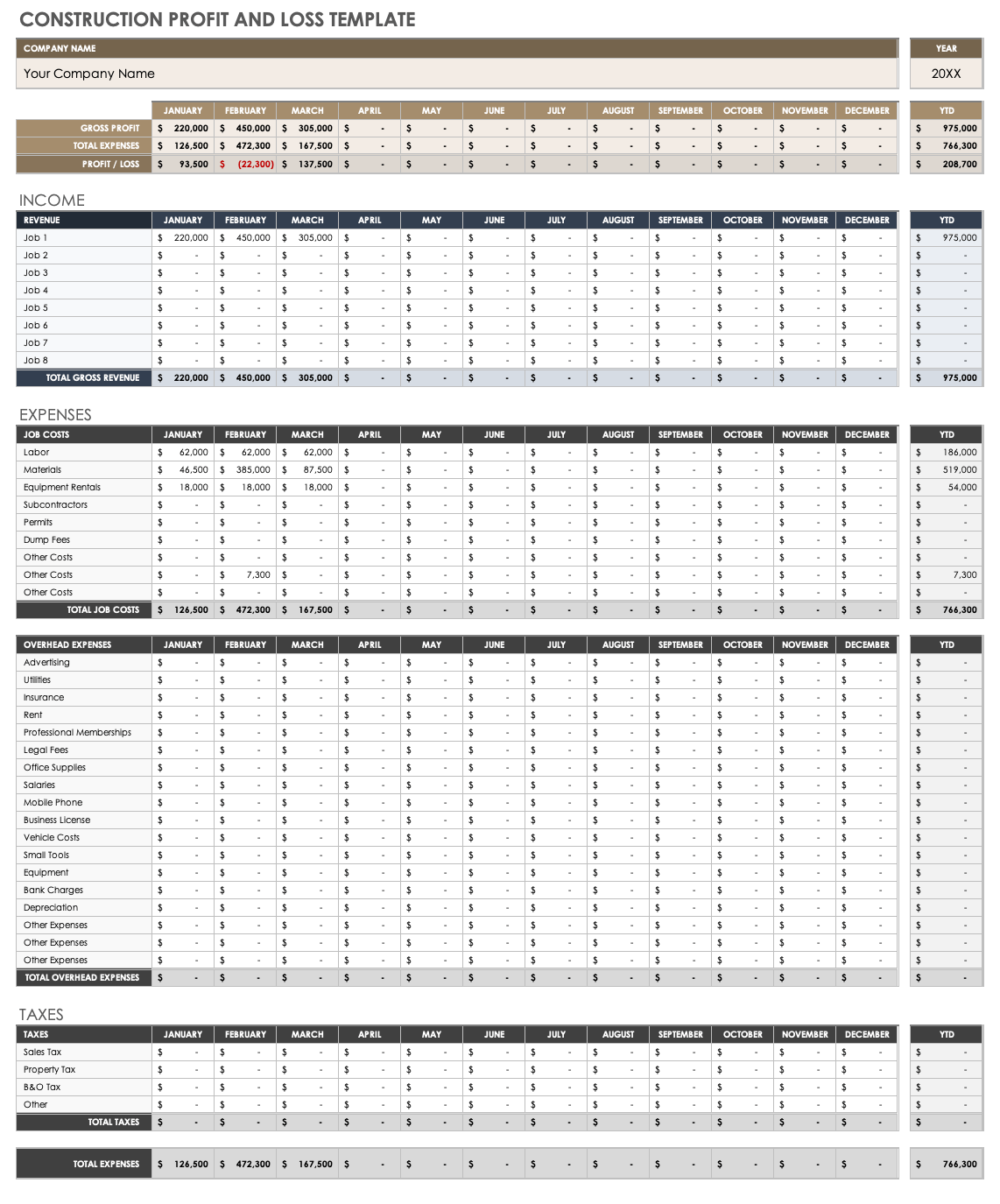
Download Construction Profit and Loss Template Microsoft Excel | Google Sheets
Accurately assess your construction company’s P&L with this comprehensive construction-specific template. The template comes pre-filled with numbered jobs in the Revenue section and construction-specific costs in its Expenses section (e.g., labor, materials, equipment rentals, subcontractors, permits, dump fees, etc.). The template also provides sections for overhead expenses and taxes, so that you can provide owners, construction financial managers, or other stakeholders with an accurate, month-by-month financial picture of your construction company’s total profits.
Home Business Profit and Loss Statement Template
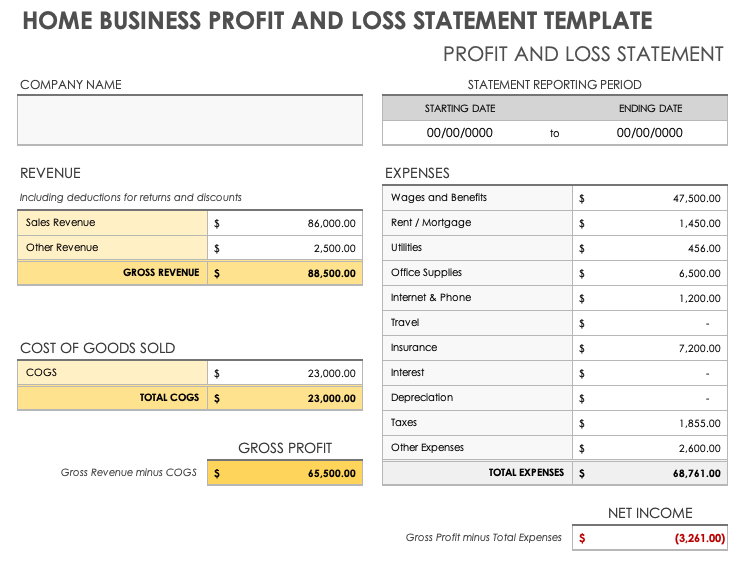
Download Home Business Profit and Loss Statement Template Microsoft Excel | Google Sheets
Gain instant insight into your home business’s actual profits and losses with this straightforward template. Enter your desired reporting period, and then add figures to determine your gross revenue, COGS, and gross profit. Then, itemize your home business’s expenses (e.g., rent/mortgage, utilities, office supplies, internet & phone, etc.) to calculate your net income. This single-page template is the perfect fit for home businesses looking to gain quick insight into their financial position.
Profit and Loss Chart Template
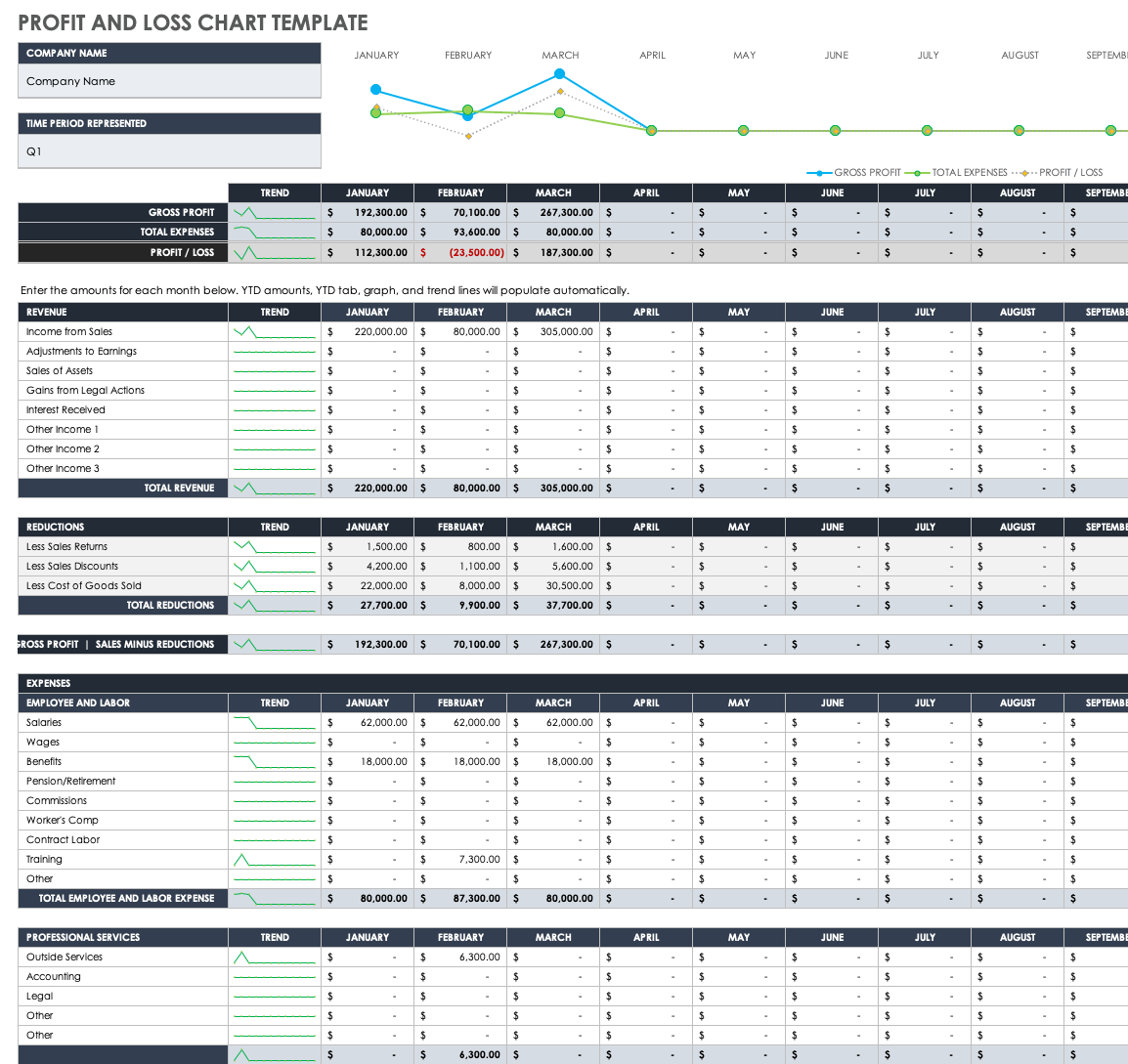
Download Profit and Loss Chart Template Microsoft Excel | Google Sheets
Chart your company’s actual profits and losses for any period of time with this visually-rich profit and loss chart template. Enter total revenues and expenses, and the template will automatically calculate your profit/loss ratio. The Trend section of the template charts your gross profit and total expenses, and provides you with your current P&L.
Rental Property Profit and Loss Statement Template
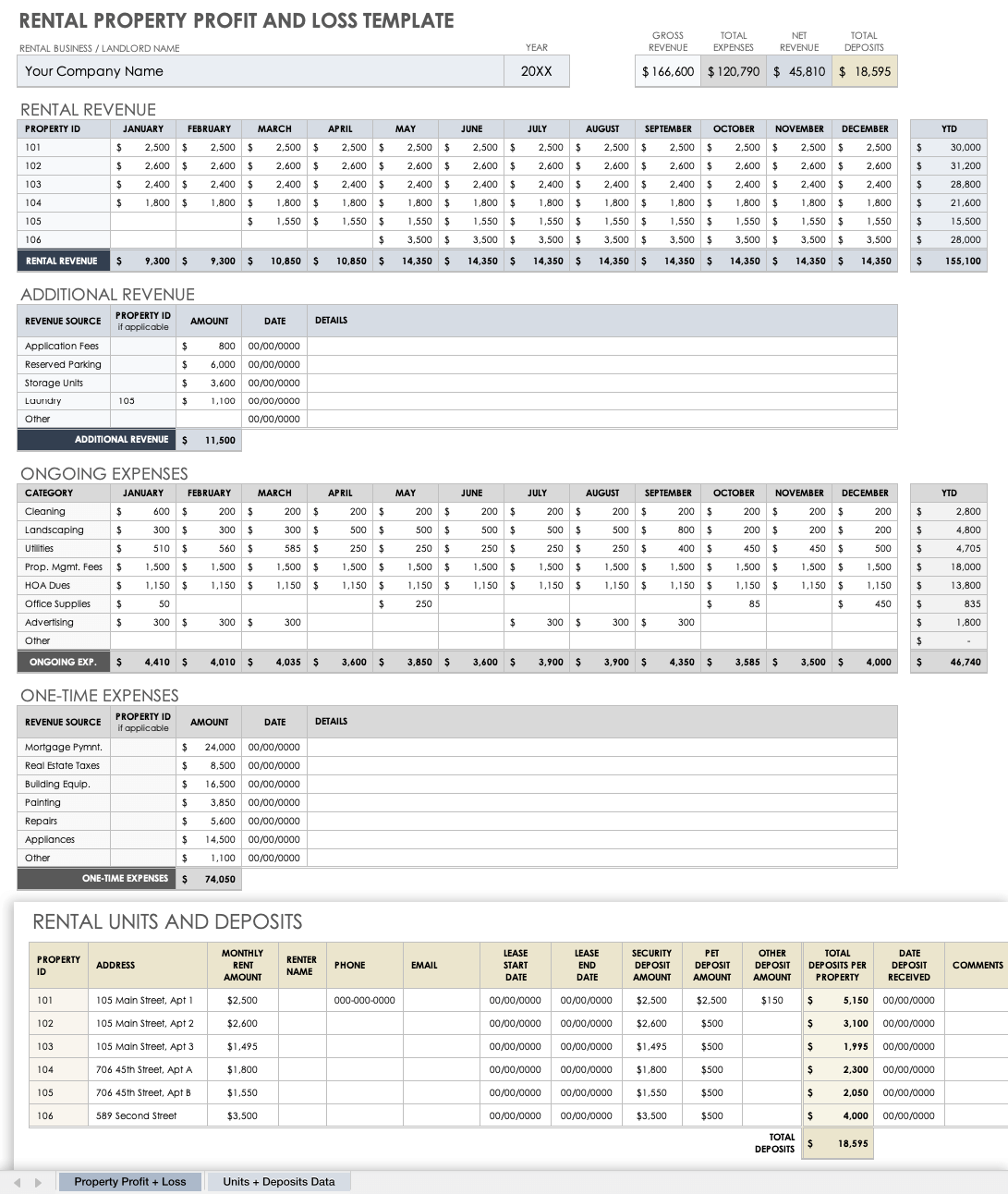
Download Rental Property Profit and Loss Template — Microsoft Excel
Determine whether your rental revenue is exceeding the cost of maintenance and other rental property-related expenses with this P&L template. List the revenues of each property, additional rental-related revenue (e.g., application fees, reserve parking, storage unit, laundry, etc.), and ongoing expenses (e.g., cleaning, landscaping, utilities, advertising, HOA fees, etc.).
Then, the dashboard-style tally will provide you with your properties’ gross revenue minus total expenses, to give you your net revenue. In the Deposits tab, list all renters’ deposits, and the template will calculate totals in the Total Deposits column. This template enables you to keep track of whether these deposits need to be returned or can be kept as compensation once renters vacate the space.
Personal Profit and Loss Template
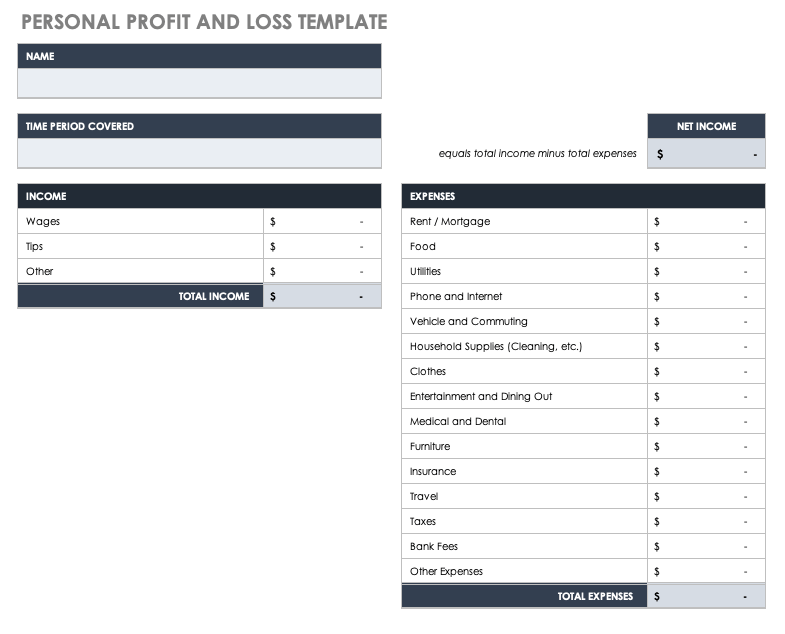
Download Personal Profit and Loss Template — Microsoft Excel
Individuals and families can use the profit and loss model to track their income against their spending and see if they are spending more or less than they make. This template is customized to include personal expense categories, such as entertainment, food, and household supplies.
Advanced Profit and Loss Template
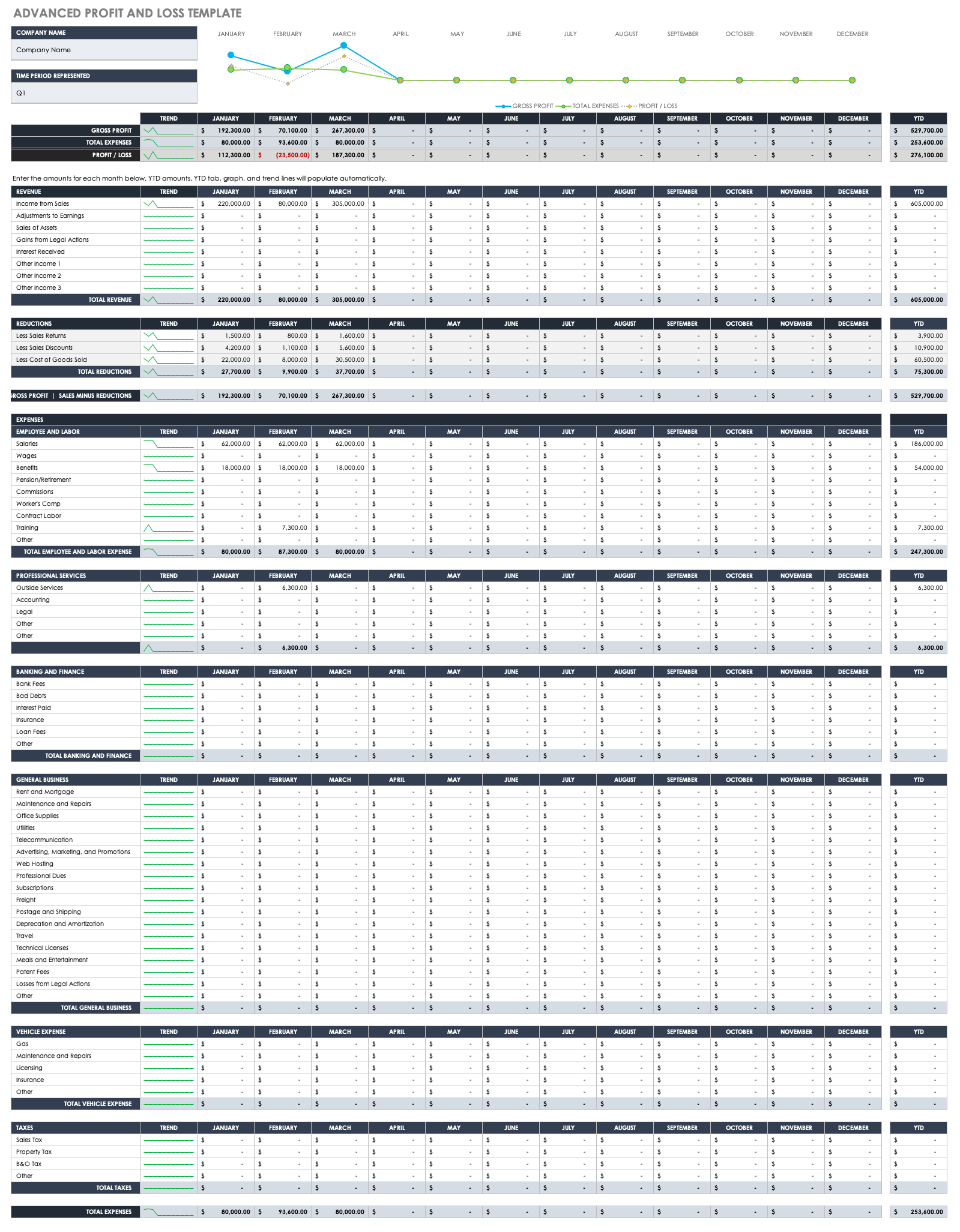
Download Advanced Profit and Loss Template — Microsoft Excel
This particular template contains many more categories than do the other templates in this article, and allows for a more detailed breakdown of expenses and revenue. The categories are grouped into sections. Enter data on the monthly tab, and see the year-to-date totals on the YTD tab. The monthly tab also has a chart that tracks month-to-month changes in total revenue and total expenses. This template can be used by service, retail, and B2B organizations. To use this template for multiple years, make a copy for each year.
See how Smartsheet can help you be more effective
Watch the demo to see how you can more effectively manage your team, projects, and processes with real-time work management in Smartsheet.
Watch a free demo
What Is a Profit and Loss Template?
Businesses use profit and loss (P&L) templates to list revenue and expenses to determine profitability. Use a P&L template to calculate your net income (gross income minus expenses), and whether you need to increase income or reduce costs.
Whether a business sells goods or provides services, a P&L statement can help determine how it has been performing in the past and predict how it may perform in the future. For new businesses, a profit and loss statement will give you a good idea of how things are going. Regardless of the type of business, the first step is to determine the period of time to be evaluated — usually for a quarter but can be a month, a year, or even a week.
P&L statements are typically prepared by owners or accountants, and used by owners, officers, and shareholders to get a feel for the state of the business. A P&L statement can also give potential investors or buyers a quick view of the state of the business.
Individuals can also use a profit and loss template to track their personal expenses and income so they know if they are saving money or spending more than they make.
While P&L templates may vary, most include the following components:
- Company Name: Enter the name of your company.
- Statement Reporting Period: Select a reporting period for the P&L statement (e.g., weekly, monthly, quarterly, annually, etc.).
- Revenue: List all sources of revenue (e.g., sales, dividends, interest, rent, etc.) and the associated monetary amounts.
- Gross Revenue: List and review your gross revenue.
- Cost of Goods Sold: Enter the cost of goods sold by your company. This figure includes materials and labor costs, but excludes indirect expenses, such as sales and distribution costs.
- Gross Profit: Review your gross profit (i.e., your gross revenue minus COGS) for accuracy.
- Expenses: Itemize all of your expenses (e.g., wages and benefits, rent or mortgage, utilities, office supplies, etc.).
- Total Expenses: Add up all your itemized expenses to find your total expenses.
- Net Income: Calculate your net income by subtracting your total expenses from your gross profit.
Additionally, some more advanced P&L templates include the following additional components:
- Reductions: Enter any less sales returns, less sales discounts, or less cost of goods sold related to inventory, which will affect inventory costs (e.g., shipping, handling, insurance, etc.).
- Net Sales: To calculate net sales, subtract any discounts, allowances, or returns from your gross sales amount.
- Cost of Sales: List the total of all the costs accrued by selling your products or services.
- Tax Rate: Enter the tax rate your organization pays on its earned income.
- Taxes: Itemize your expenses related to taxes to determine your true net income after taxes. Doing so helps you estimate your organization’s income tax liabilities.
Once you’ve completed these steps, you’ll see your net profit or loss.
Additionally, note that operating income can be determined by subtracting gross profit from total expenses, and that operating expenses can be determined by adding all expenses.
Increase Transparency with Smartsheet for Profit and Loss Statements
Empower your people to go above and beyond with a flexible platform designed to match the needs of your team — and adapt as those needs change.
The Smartsheet platform makes it easy to plan, capture, manage, and report on work from anywhere, helping your team be more effective and get more done. Report on key metrics and get real-time visibility into work as it happens with roll-up reports, dashboards, and automated workflows built to keep your team connected and informed.
When teams have clarity into the work getting done, there’s no telling how much more they can accomplish in the same amount of time. Try Smartsheet for free, today.
Discover why over 90% of Fortune 100 companies trust Smartsheet to get work done.
- What is the Profit and Loss Statement (P&L)?
Structure of the Profit and Loss Statement
- Example Profit and Loss Statement (P&L)
Download the Profit and Loss Template
Income accounts vs expenditure accounts.
- Impact of Accounting Principles on the P&L Statement
Beyond the Profit and Loss Statement
- How to Analyze a Profit and Loss Statement (P&L)
Profit and Loss Statement Video Explanation
Additional resources, profit and loss statement (p&l).
A summary of income and expenditures for a business
What is the Profit and Loss Statement (P&L)?
A profit and loss statement (P&L), or income statement or statement of operations, is a financial report that provides a summary of a company’s revenues, expenses, and profits/losses over a given period of time. The P&L statement shows a company’s ability to generate sales, manage expenses, and create profits. It is prepared based on accounting principles that include revenue recognition, matching, and accruals, which makes it different from the cash flow statement.

Image: CFI’s Financial Analysis Fundamentals .
A company’s statement of profit and loss is portrayed over a period of time, typically a month, quarter, or fiscal year.
The main categories that can be found on the P&L include:
- Revenue (or Sales)
- Cost of Goods Sold (or Cost of Sales)
- Selling, General & Administrative (SG&A) Expenses
- Marketing and Advertising
- Technology /Research & Development
- Interest Expense
Example Profit and Loss Statement (P&L)
Below is an example of Amazon’s 2015-2017 P&L statement, which they call the Consolidated Statement of Operations. To learn how to analyze these financial statements, check out CFI’s Advanced Financial Modeling Course on Amazon .

Image: CFI’s Amazon Financial Analysis Course .
Looking at the above example, we see that Amazon posted a profit of $596 million in 2015, a profit of $2.4 billion in 2016, and a profit of $3.0 billion in 2017.
Amazon breaks down its total revenue into product sales and service sales. Its operating expenses consist of cost of sales, fulfillment, marketing, technology, G&A, and others. At this point, it provides a subtotal on the statement for Operating Income, also commonly referred to as Earnings Before Interest and Taxes (EBIT).
Below that, interest expense and taxes are deducted to finally arrive at the net profit or loss for the period. To learn more, read Amazon’s annual report .
Download the free Excel template now to advance your knowledge of financial modeling.
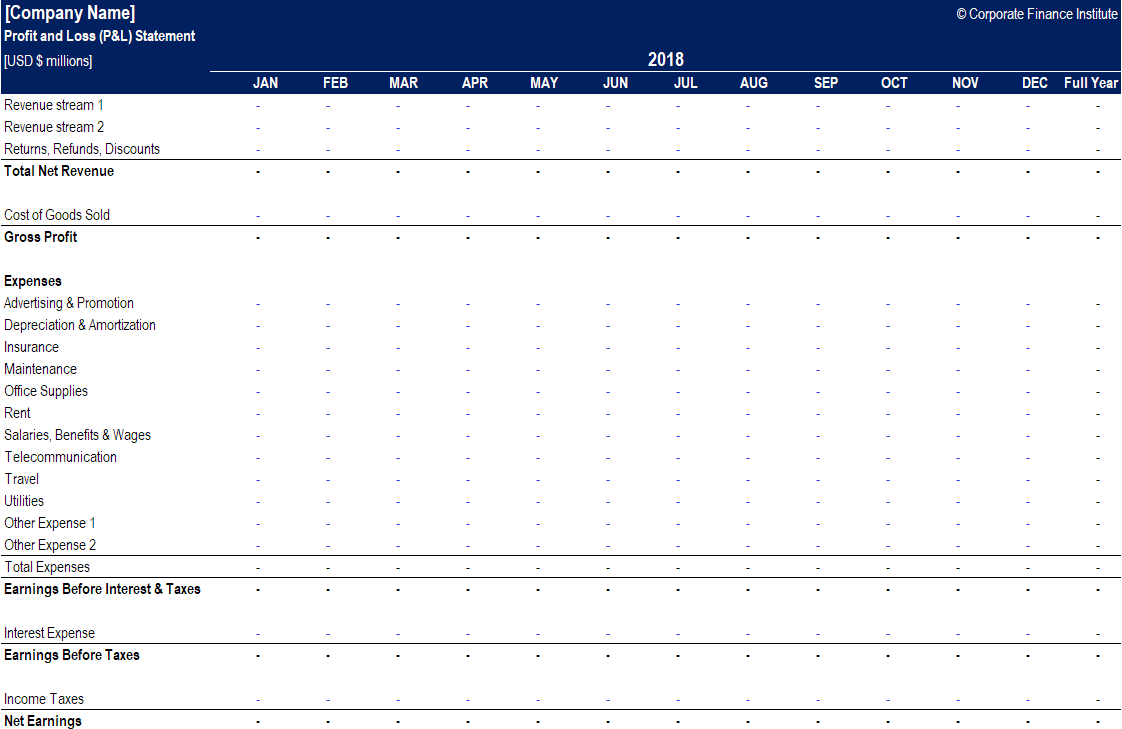
There are two main categories of accounts for accountants to use when preparing a profit and loss statement.
The table below summarizes these two accounts: income and expenditures.
| Income | Expenditure |
|---|---|
| Revenue | Cost of Goods Sold |
| Sales | Marketing and Advertising |
| Interest Income | Selling, General & Administrative |
| Gains | Salaries, Benefits & Wages |
| Fees Charged | Interest Expense |
| Commissions Earned | Insurance |
| Rental Income | Telecommunication |
| Professional Fees | |
| Taxes |
Impact of Accounting Principles on the P&L Statement
It might not seem obvious by looking at a profit and loss statement, but the final figure at the bottom (i.e., the total profit or the total loss) may be very different from the actual amount of cash that’s made or lost.
The main factors that create a difference between profit and cash generation are:
- Revenue recognition principle – revenue is often recognized before cash is received (which creates accounts receivable on the balance sheet)
- Matching principle – expenses are matched to revenues during the period(s) those revenues are earned
- Accrual principle – income and expenditures should be recorded during the periods they occur, not when cash is received, which can make revenue and expenses materially different from cash flow
Analysts must go beyond the profit and loss statement to get a full picture of a company’s financial health. To properly assess a business, it’s critical to also look at the balance sheet and the cash flow statement.
1. Analyzing the Balance Sheet
The balance sheet shows a company’s assets, liabilities, and equity at a specific point in time. This snapshot of the company’s financial position is important for assessing:
- The company’s asset base – ability to generate future revenues
- Liabilities – future obligations the company has to meet
- Working capital – the company’s short-term liquidity position
- Capital structure – how a company is financed between debt and equity
2. Analyzing the Cash Flow Statement
The statement of cash flow shows how much cash a company generated and consumed over a period of time. It consists of three parts: cash from operations, cash used in investing, and cash from financing. This statement is important for assessing:
- The company’s ability to generate cash from operations
- Free Cash Flow generation
- How much money has been raised (debt and or equity)
- The net change in cash position over the period
- The start and end of period cash balance
How to Analyze a Profit and Loss Statement (P&L)
One of the main jobs of a professional financial analyst is to analyze the P&L of a company in order to make recommendations about the financial strength of the company, attractiveness of investing in it, or acquiring the entire business.
Examples of P&L statement analysis include:
- Comparing year-over-year numbers (horizontal analysis) as well as industry benchmarking
- Looking at margins: gross profit margin, EBITDA margin, operating margin, net profit margin
- Trend analysis: are metrics improving or deteriorating
- Rates of return: return on equity (ROE), return on assets (ROA)
- Valuation metrics: EV/EBITDA, P/E ratio, Price to Book, etc
Below is a video explanation of how the profit and loss statement (income statement) works, the main components of the statement, and why it matters so much to investors and company management teams.
Video: CFI’s Free Financial Analyst Courses .
Thank you for reading CFI’s guide to understanding the profit and loss statement. CFI is on a mission to help you advance your career. With that goal in mind, these additional CFI resources will be very helpful:
- Free Reading Financial Statements Course
- Profit and Loss Template
- Income Statement Template
- Profit and Loss (P&L) Statement Template
- Financial Modeling Guide
- See all accounting resources
- See all capital markets resources
- Share this article

Create a free account to unlock this Template
Access and download collection of free Templates to help power your productivity and performance.
Already have an account? Log in
Supercharge your skills with Premium Templates
Take your learning and productivity to the next level with our Premium Templates.
Upgrading to a paid membership gives you access to our extensive collection of plug-and-play Templates designed to power your performance—as well as CFI's full course catalog and accredited Certification Programs.
Already have a Self-Study or Full-Immersion membership? Log in
Access Exclusive Templates
Gain unlimited access to more than 250 productivity Templates, CFI's full course catalog and accredited Certification Programs, hundreds of resources, expert reviews and support, the chance to work with real-world finance and research tools, and more.
Already have a Full-Immersion membership? Log in
- Starting a Business
Our Top Picks
- Best Small Business Loans
- Best Business Internet Service
- Best Online Payroll Service
- Best Business Phone Systems
Our In-Depth Reviews
- OnPay Payroll Review
- ADP Payroll Review
- Ooma Office Review
- RingCentral Review
Explore More
- Business Solutions
- Entrepreneurship
- Franchising
- Best Accounting Software
- Best Merchant Services Providers
- Best Credit Card Processors
- Best Mobile Credit Card Processors
- Clover Review
- Merchant One Review
- QuickBooks Online Review
- Xero Accounting Review
- Financial Solutions
Human Resources
- Best Human Resources Outsourcing Services
- Best Time and Attendance Software
- Best PEO Services
- Best Business Employee Retirement Plans
- Bambee Review
- Rippling HR Software Review
- TriNet Review
- Gusto Payroll Review
- HR Solutions
Marketing and Sales
- Best Text Message Marketing Services
- Best CRM Software
- Best Email Marketing Services
- Best Website Builders
- Textedly Review
- Salesforce Review
- EZ Texting Review
- Textline Review
- Business Intelligence
- Marketing Solutions
- Marketing Strategy
- Public Relations
- Social Media
- Best GPS Fleet Management Software
- Best POS Systems
- Best Employee Monitoring Software
- Best Document Management Software
- Verizon Connect Fleet GPS Review
- Zoom Review
- Samsara Review
- Zoho CRM Review
- Technology Solutions
Business Basics
- 4 Simple Steps to Valuing Your Small Business
- How to Write a Business Growth Plan
- 12 Business Skills You Need to Master
- How to Start a One-Person Business
- FreshBooks vs. QuickBooks Comparison
- Salesforce CRM vs. Zoho CRM
- RingCentral vs. Zoom Comparison
- 10 Ways to Generate More Sales Leads
Business.com aims to help business owners make informed decisions to support and grow their companies. We research and recommend products and services suitable for various business types, investing thousands of hours each year in this process.
As a business, we need to generate revenue to sustain our content. We have financial relationships with some companies we cover, earning commissions when readers purchase from our partners or share information about their needs. These relationships do not dictate our advice and recommendations. Our editorial team independently evaluates and recommends products and services based on their research and expertise. Learn more about our process and partners here .
What Is a Profit and Loss Statement?
A profit and loss statement summarizes a business’s revenue and expenses. Learn how to use a profit and loss statement to gain information about your business.

Table of Contents
At some point, you’ve probably heard the phrase, “It takes money to make money.” But if you’re not careful, it’s easy to let your expenses spiral out of control and reach a point where you’re making little to no profit.
That’s why all businesses need to track their revenue and expenses with a profit and loss (P&L) statement. A P&L statement will help you measure your company’s financial health and see how your business is doing.
Here’s a look at what a P&L statement is, what it includes and how you can use one to gain information about your business.
Editor’s note: Looking for the right accounting software for your business? Fill out the below questionnaire to have our vendor partners contact you about your needs.
What is a P&L statement?
A P&L statement is a financial report that summarizes a company’s revenue, expenses and profits or losses over a fiscal year or quarter. When you read a P&L statement, you’ll see whether the company can generate sales, manage expenses and earn a profit.
The two main categories outlined in a P&L statement are income and expenses. Income includes things like product sales, interest earned, commissions or rental income. Expenses include the cost of goods sold (COGS), marketing and advertising fees and taxes.
Why do businesses need to track P&L?
If you aren’t a publicly traded company with shareholders to report to, you may wonder why it’s necessary to create a P&L statement. But this financial statement gives you the following essential information about your business.
Profitability of your business
A P&L statement will indicate whether your business is profitable by showing whether you’re losing money on the sale of your products or services. Tracking this information could help you come up with new ideas on how to increase sales.
Insight on how your business is performing
When you run a business, you want to look at more than your overall income. You also want to observe trends in your business and whether it’s growing over time. Tracking industry trends can help you determine the specific actions you should be taking in your business.
For instance, if your gross revenue has been down since the beginning of the year, you need to focus on increasing sales. If your gross revenue is satisfactory, but the net income is down, look for ways to cut expenses.
The overall health of your business
At some point, you may need to apply for a small business loan. As part of the requirements for getting approved , your lender will ask for financial documents like a P&L statement. This document gives lenders a look at your business’s overall health and shows them whether or not it’s earning a profit.
Even if you never apply for financing, it’s a good idea to generate a P&L statement at least once a year. The information you gather will help you make better business decisions. Fortunately, creating a P&L statement is easier than you might think.
What information do you need for a P&L?
A typical P&L statement will include four main sections: revenue, expenses, COGS and net income. Each section will make up a new line on the P&L statement.
A company’s revenue is its net sales during a given financial period. The revenue section will outline the revenue earned from its primary business activities. It will also show non-operating revenue and income earned from the sale of business assets .
Your expenses are what you spend on the day-to-day operations of running your business. It includes things like business insurance, marketing costs and rent. These expenses are necessary to keep your business running but don’t directly help you produce more revenue.
This section shows how much it costs your company to produce its products or services. For instance, if a business sells physical products, this section might include labor or materials. The COGS will not include overhead costs like rent payments.
Here is the formula you’ll use to calculate the COGS:
Beginning Inventory + Purchases – Ending Inventory = COGS
You may notice that while the COGS is technically an expense, it’s not included in the expenses section. That’s because businesses separate the COGS for tax purposes. The IRS says that businesses can deduct the COGS from their taxable earnings, which reduces their overall tax obligations.
Your net income is included at the bottom of a P&L statement. It’s what’s left after you subtract your expenses from your revenue.
If your net income shows that you earned a profit, your business is making more than it spends. If the company is spending more than it brings in, you have a net loss for that financial period.
What is included in a P&L statement?
Here is some of the information you should include in a P&L statement:
- Total revenue
- Total expenses
- Selling, general and administrative expenses
- Research and development expenses
- Marketing and advertising costs
- Interest paid
- Depreciation
- Earnings before interest, taxes, depreciation and amortization
A P&L statement includes a variety of information, but certain items won’t be listed. For instance, you won’t include your business’s assets, liabilities or equity.
Example of a P&L
Below is a copy of General Motors’ 2018-2020 P&L statement, which the company refers to as its Consolidated Income Statement. You’ll notice that GM posted a net income of $6.4 billion in 2020, according to The Detroit News , despite the pandemic.

How accounting software can help manage your P&L statement
Creating a P&L statement isn’t difficult and you could do it on your own. However, the process is much easier if you use accounting software, which will help you stay on top of your small business accounting challenges and help you avoid common accounting mistakes .
With the right accounting software, you’ll already be tracking your revenue and expenses regularly. That means you can generate a P&L statement easily at the end of the quarter or year.
If you’re trying to find the right accounting software, here are some of the best options.
QuickBooks is our pick for the best accounting software for small businesses. The company provides a wide range of payment tiers, so its software can support you at every stage of your business. QuickBooks is a good option for everyone, whether you’re a solopreneur or running an enterprise company.
QuickBooks provides many features, including the ability to generate financial reports like a P&L statement. It will sort your transactions for you automatically, and you can track your company’s cash flow from your dashboard.
You can check out our QuickBooks review for more information.
FreshBooks is a cloud-based accounting and invoicing software you can access from any device. It’s a good option for freelancers or individuals who aren’t well-versed in accounting.
The software uses double-entry accounting, so you can easily create financial reports like a P&L statement and gain insight into your business’s financial health. You can also invite your accountant to collaborate with you on your FreshBooks account.
Be sure to read our FreshBooks review for more information.
We chose Xero as the best option for growing businesses because the software offers flexible features and a variety of pricing plans. It has all the features you need when you’re just getting started, as well as advanced features like payroll and inventory management.
You can use Xero to track your expenses and understand your real-time cash position. You can also use the software to create financial reports and prepare for tax season.
You can learn more by reading our full review of Xero .
Oracle NetSuite
Oracle NetSuite’s software is one of the best options for automating your business accounting. You’ll only pay for the features you use, so it’s a great option for small businesses that plan to scale in the future.
You can use the software to reconcile transactions, manage accounts payables and receivables and create financial reports. Since the software is cloud-based, you can access your financial data from anywhere.
Find out more by reading our online Oracle NetSuite review .
P&L statements provide valuable insights into your business
A P&L statement provides an overview of how much your business is earning and whether you’re making or losing money. Companies of all sizes can benefit from creating and reviewing a P&L statement regularly.
If you’re new to P&L statements, you can create one using a template or you might want to consider investing in feature-rich accounting software .
Software like QuickBooks or Xero can help you track and manage your expenses and generate a P&L statement within seconds. That way, you can stay on top of your finances and be prepared come tax season.

Get Weekly 5-Minute Business Advice
B. newsletter is your digest of bite-sized news, thought & brand leadership, and entertainment. All in one email.
Our mission is to help you take your team, your business and your career to the next level. Whether you're here for product recommendations, research or career advice, we're happy you're here!
S corps and partnership extension deadline Sept. 16
Customer login
Tax Pro login
Bookkeeping
Understanding Profit and Loss Statements (P&L): Templates and Examples
8 minute read
Copy Article URL
Understanding a Profit and Loss Statement (P&L): Including an Example of a Profit and Loss Statement Template
Kristal Sepulveda, CPA
November 28, 2023

A clear understanding of your financial health is paramount to success in business. At the heart of financial analysis lies the Profit and Loss Statement (P&L), an income statement. This crucial document encapsulates a company's revenues, costs, and expenses over a specific timeframe. This article is dedicated to demystifying the intricacies of the Profit and Loss Statement, shedding light on its significance for businesses. By unraveling the complexities surrounding P&L statements, we aim to equip business owners with the knowledge to navigate their financial terrain effectively. From explaining the components of a P&L template to highlighting its integration with other financial statements, this guide aims to empower businesses to make informed financial decisions and ensure sustainable growth.

Why Understanding Profit and Loss Statements is Crucial for Your Business
In the world of business, understanding your financial health is paramount. A profit and loss statement (P&L), or an income statement , is a crucial financial statement that summarizes the revenues, costs, and expenses incurred during a specific period. It's a key indicator of your business's financial performance, offering insights into your ability to generate profit by increasing revenue, reducing costs, or both. This blog post aims to demystify the profit and loss statement, explaining its importance and guiding you through creating an effective template to streamline your financial management.
Further reading: Comparing Financial Metrics: Analyzing Profit and Loss Statements vs. Income Statements
What is a profit and loss statement (p&l).
A profit and loss statement, or a P&L statement or income statement, is a financial document that summarizes a company's revenues, expenses, and profits/losses over a given period. It starts with the top line (total revenue) and ends with t he bottom line (net income or net profit/loss) . By examining a P&L statement, business owners and investors can gauge a business's financial health and profitability.
Why is a Profit and Loss Statement Important for Small Businesses?
For small business owners, a P&L statement is more than just a financial document; it reflects the business's financial health and operational efficiency. It helps understand whether the business is profitable, where the major expenses are, and how revenue streams perform. Regularly reviewing this statement can inform strategic decisions, such as where to cut costs or how to boost revenue.
How Can a Profit and Loss Template Help Grow Your Business Profits?
Utilizing a profit and loss template simplifies preparing a P&L statement. It ensures consistency, accuracy, and completeness in presenting financial information. A well-structured template can also save time and help quickly identify trends, which is crucial for making timely decisions to foster business growth.
Types of Profit and Loss Statements: Which One Suits Your Business?
There are various types of P&L statements, each serving different purposes. The most common types are the traditional P&L statement, the comparative statement (comparing periods), and the common size statement (showing each item as a percentage of revenue). Choosing the right type depends on your business needs and the kind of financial analysis you intend to perform.
Key Components of a Profit and Loss Statement Template
A comprehensive P&L template should include several key components: revenue, cost of goods sold (COGS), gross profit, operating expenses , and net income. Each component is crucial in providing a complete picture of the business's financial performance.
Simple vs Detailed: Choosing the Right Profit and Loss Template
The choice between a simple and a detailed P&L template depends on the size and complexity of your business. Small businesses opt for a simpler template focusing on the key figures, whereas larger businesses require a detailed template to capture various revenue streams and expense categories.
Further reading: Mastering Cost Volume Profit (CVP) Analysis: Understanding Income Statements and Cost Behavior
Example of a profit and loss statement.
Simple Profit and Loss Statement Template
For the Period: [Specify Period, e.g., January 1, 2023, to December 31, 2023]
Business Name: [Your Business Name]
- Total Sales Revenue: $[Total amount of sales]
- Other Income: $[Any other income]
Total Revenue: $[Sum of Sales Revenue and Other Income]
II. Costs and Expenses
- Cost of Goods Sold (COGS): $[Direct costs associated with the product/service]
- Operating Expenses:
- Rent: $[Amount]
- Utilities: $[Amount]
- Salaries and Wages: $[Amount]
- Marketing and Advertising: $[Amount]
- Insurance: $[Amount]
- Other Expenses: $[List other operational expenses]
Total Expenses: $[Sum of all expenses]
III. Net Income
- Gross Profit (Revenue - COGS): $[Total Revenue minus COGS]
- Net Income (Gross Profit - Total Expenses): $[Gross Profit minus Total Expenses]
Here's an example of this table when applied to a fictional business:
| Business Name | I. Revenue |
|---|---|
| XYZ Enterprises | Total Sales Revenue: $500,000 |
| Other Income: $10,000 | |
| Total Revenue: $510,000 | |
| II. Costs and Expenses | |
| Cost of Goods Sold (COGS): $200,000 | |
| Rent: $30,000 | |
| Utilities: $5,000 | |
| Salaries and Wages: $150,000 | |
| Marketing and Advertising: $20,000 | |
| Insurance: $7,000 | |
| Other Expenses: $15,000 | |
| Total Expenses: $227,000 | |
| III. Net Income | |
| Gross Profit: $310,000 | |
| Net Income: $83,000 |
In this example:
- Total Sales Revenue is $500,000.
- Other Income (perhaps from investments or other sources) is $10,000.
- The Cost of Goods Sold (COGS) is $200,000.
- Operating Expenses include Rent ($30,000), Utilities ($5,000), Salaries and Wages ($150,000), Marketing and Advertising ($20,000), Insurance ($7,000), and Other Expenses ($15,000), totaling $227,000.
- Gross Profit is calculated as Total Revenue minus COGS ($510,000 - $200,000 = $310,000).
- Net Income is calculated as Gross Profit minus Total Expenses ($310,000 - $227,000 = $83,000).
Integrating the Profit and Loss Statement with the Balance Sheet and Cash Flow Statement
A profit and loss statement should not be viewed in isolation. Integrating it with other financial statements like the balance sheet and cash flow statement provides a more holistic view of your business's financial position. This integration allows for a comprehensive analysis of your company's financial health.
Quarterly vs Annual Statements: What’s Best for Your Business?
Whether to prepare quarterly or annual P&L statements depends on your business requirements. Quarterly statements are useful for tracking progress and adjusting throughout the year, while annual statements provide a broader view of your financial performance.
Common Mistakes to Avoid in Preparing a Profit and Loss Statement
Common mistakes in preparing a P&L statement include incorrect categorization of expenses, overlooking certain revenues or expenses, and needing to update the statement regularly. Avoiding these errors ensures the accuracy and reliability of your financial analysis.
Using a Profit and Loss Statement to Make Informed Business Decisions
A well-prepared P&L statement is a powerful tool for making informed business decisions. It allows business owners to identify profitable areas, areas requiring attention, and opportunities for cost savings. Analyzing trends over time can also inform strategic planning and help set realistic financial goals.
Key Takeaways from the Profit and Loss Statement Guide
- Understanding Profit and Loss Statement : A crucial financial statement that shows the profitability of a business by detailing revenue, costs, and expenses.
- Net Income Calculation : Calculated by subtracting total expenses from total revenue, reflecting the company's profitability.
- Significance of Templates : Templates streamline the creation of a P&L statement, ensuring consistency and accuracy in financial reporting.
- Gross Profit : Represents total revenue minus the cost of goods sold, indicating the efficiency of core business activities.
- Financial Statement Integration : Integrating P&L with other financial statements like balance sheets and cash flow statements offers a comprehensive view of financial health.
- Relevance for Small Business : Particularly crucial for small businesses to monitor profitability, manage expenses, and guide strategic decisions.
- Operating Expenses and Revenue Tracking : Key for understanding how business operations contribute to overall financial performance.
- Quarterly and Fiscal Year Analysis : Regular analysis (quarterly or annually) helps track progress and make informed decisions.
- Importance of Revenue and Expenses Management : Essential for maintaining a healthy balance between income and outgoings to ensure business sustainability.
- Profit Margin and Net Profit : Indicators of how much profit a business makes relative to its revenue and overall earnings .
- Liability Management : Understanding liabilities through the P&L statement helps maintain a strong financial position.
- Using Profit and Loss Statement for Business Plan : A vital tool for strategic planning, helping to project future revenue and expenses.
- Profit or Loss Insights : Provides insights into whether a business is making a profit or incurring a loss and by how much.
- Cash Flow Insights : Though different from a cash flow statement, the P&L provides insights into the operational cash flow.
- Business Owners and Investors : Useful for both owners and investors to assess a business's financial performance and potential.
- P&L as a Financial Snapshot : Offers a snapshot of the company's financial performance over a specific period.
- Types of Profit and Loss Statements : Different types cater to analytical needs, like comparative statements for periodical comparisons.
- Gross Profit Margin Analysis : Helps understand the profitability of products or services sold.
- Investor Analysis : Investors use P&L statements to assess the viability and profitability of a business.
- Simple vs Detailed P&L Statements : Choice depends on business size and complexity; detailed statements offer more granular financial insights.
- Preparing a Profit and Loss Statement : Involves careful categorization and regular updating to ensure accuracy.
- Profit and Loss for Business Growth : This can be used to identify growth areas and make informed decisions to increase profitability.
- Understanding Total Business Financials : A comprehensive view of total business revenue, expenses, and net income or loss.
How can Taxfyle help?
Finding an accountant to manage your bookkeeping and file taxes is a big decision. Luckily, you don't have to handle the search on your own.
At Taxfyle , we connect small businesses with licensed, experienced CPAs or EAs in the US. We handle the hard part of finding the right tax professional by matching you with a Pro who has the right experience to meet your unique needs and will manage your bookkeeping and file taxes for you.
Get started with Taxfyle today , and see how finances can be simplified.
Legal Disclaimer
Tickmark, Inc. and its affiliates do not provide legal, tax or accounting advice. The information provided on this website does not, and is not intended to, constitute legal, tax or accounting advice or recommendations. All information prepared on this site is for informational purposes only, and should not be relied on for legal, tax or accounting advice. You should consult your own legal, tax or accounting advisors before engaging in any transaction. The content on this website is provided “as is;” no representations are made that the content is error-free.

Was this post helpful?
Did you know business owners can spend over 100 hours filing taxes, it’s time to focus on what matters..
With Taxfyle, the work is done for you. You can connect with a licensed CPA or EA who can file your business tax returns. Get $30 off off today.
Want to put your taxes in an expert’s hands?
Taxes are best done by an expert. Here’s a $30 coupon to access to a licensed CPA or EA who can do all the work for you.
Is this article answering your questions?
Thanks for letting us know.
Whatever your questions are, Taxfyle’s got you covered. If you have any further questions, why not talk to a Pro? Get $30 off today.
Our apologies.
Taxes are incredibly complex, so we may not have been able to answer your question in the article. Fortunately, the Pros do have answers. Get $30 off a tax consultation with a licensed CPA or EA, and we’ll be sure to provide you with a robust, bespoke answer to whatever tax problems you may have.
Do you do your own bookkeeping?
There’s an easier way to do bookkeeping..
Taxfyle connects you to a licensed CPA or EA who can take time-consuming bookkeeping work off your hands. Get $30 off today.
Why not upgrade to a licensed, vetted Professional?
When you use Taxfyle, you’re guaranteed an affordable, licensed Professional. With a more secure, easy-to-use platform and an average Pro experience of 12 years, there’s no beating Taxfyle. Get $30 off today.
Are you filing your own taxes?
Do you know if you’re missing out on ways to reduce your tax liability.
Knowing the right forms and documents to claim each credit and deduction is daunting. Luckily, you can get $30 off your tax job.
Get $30 off your tax filing job today and access an affordable, licensed Tax Professional. With a more secure, easy-to-use platform and an average Pro experience of 12 years, there’s no beating Taxfyle.
How is your work-life balance?
Why not spend some of that free time with taxfyle.
When you’re a Pro, you’re able to pick up tax filing, consultation, and bookkeeping jobs on our platform while maintaining your flexibility.
Why not try something new?
Increase your desired income on your desired schedule by using Taxfyle’s platform to pick up tax filing, consultation, and bookkeeping jobs.
Is your firm falling behind during the busy season?
Need an extra hand.
With Taxfyle, your firm can access licensed CPAs and EAs who can prepare and review tax returns for your clients.
Perhaps it’s time to scale up.
We love to hear from firms that have made the busy season work for them–why not use this opportunity to scale up your business and take on more returns using Taxfyle’s network?

by this author
Share this article
Subscribe to taxfyle.
Sign up to hear Taxfye's latest tips.
By clicking subscribe, I agree to Taxfyle's Terms of Service , Privacy Policy , and am opting in to receive marketing emails.
Get our FREE Tax Guide for Individuals
Looking for something else? Check out our other guides here .
By clicking download, I agree to Taxfyle's Terms of Service , Privacy Policy , and am opting in to receive marketing emails.
File simpler.
File smarter.
File with Taxfyle.
2899 Grand Avenue, Coconut Grove, FL 33133
Copyright © 2024 Tickmark, Inc.
- Search Search Please fill out this field.
- What Does It Show?
- Why They're Public
- How Investors Use Them
The Bottom Line
- Corporate Finance
- Financial statements: Balance, income, cash flow, and equity
What Is an Example of a Profit and Loss (P&L) Statement?
J.B. Maverick is an active trader, commodity futures broker, and stock market analyst 17+ years of experience, in addition to 10+ years of experience as a finance writer and book editor.
:max_bytes(150000):strip_icc():format(webp)/picture-53889-1440688003-5bfc2a8846e0fb0083c04dc5.jpg)
A company's statement of income is often called its profit and loss statement (P&L) . It lists revenues, expenses, and net profit for the period covered. There are typically quarterly and annual P&Ls, but some companies might publish monthly P&Ls.
Public companies produce P&L statements to meet legal reporting requirements and inform investors. The P&L is carefully reviewed by market analysts, investors, and creditors to evaluate a company's revenues, expenses, and profitability.
Key Takeaways
- A P&L statement shows a company's revenues and expenses related to running the business, such as rent, cost of goods sold, freight, and payroll.
- Each entry on a P&L statement provides insight into how much money a company made and spent.
- P&L statements help companies gauge how well they're operating and benchmark current performance relative to future projections.
- They provide financial information that can be compared to that of rivals in the same industry.
- Investors and lenders use P&L statements to inform their investing or lending decisions.
What Does a Profit and Loss (P&L) Statement Show?
The P&L contains details about a company's financial circumstances. The statement generally has the following sections:
- Revenues : The total amount of income from the sale of goods or services associated with the company's primary operations.
- Expenses : Costs deducted from revenue, such as the cost of goods sold (COGS) , wages, rent, marketing, administration costs, utilities, interest expenses, and depreciation .
- Gains : Any gains during the period, such as selling unused equipment.
- Losses : Any losses incurred in the period.
- Net Income : While not necessarily a section on its own, this line item shows what was earned after accounting for everything. It is also known as the bottom line .
Due to how comprehensive it can be, the P&L statement paints a clear picture of how much money a company makes and spends. It also highlights whether the company was profitable or suffered a loss.
To ensure a proper understanding of profitability, accountants use accrual accounting to prepare the P&L statement. Accrual accounting recognizes revenue and expenses when they occur rather than when money is received or paid.
Why Profit and Loss (P&L) Statements Are Public
P&L statements are made available to the public for a variety of reasons. First, public companies in the U.S. are required to file their financial statements with the Securities and Exchange Commission (SEC) . The inner financial workings of a company are of great interest to numerous people, including accountants, economists, and investors.
Even business owners need a comprehensive understanding of a company's financial events and results. The P&L and other financial statements can help them identify unnecessary expenditures, opportunities to increase revenue, and other ways to improve performance.
For all of these professionals, assessing a company's financial strength means taking a detailed look at total revenue , expenditures, the amount of debt or leverage , additional investments, secondary operations, and tax burdens.
Financial statements, including the P&L, can help businesses understand current performance relative to projections and create realistic forecasts. They can also help business owners and investors compare a business's performance against competitors.
How Investors Use Profit and Loss (P&L) Statements
Investors and lenders use data from P&L statements to determine a company's profitability and risk level . For example, companies must provide evidence of their financial standing and ability to make consistent payments to apply for loans.
If the P&L statement reflects that a company does not generate enough operating income to adequately cover current loan payments, banks are less likely to loan additional funds. Sometimes, a downturn in income could signal loan default .
If you're an investor making important investment decisions, be sure to compare the P&L statements of companies that are similar in size and within the same industry or sector. This gives you an apples-to-apples comparison. Comparing the financial statements of a large pharmaceutical company with those of a small energy company doesn't make sense, as they have different factors that play into their revenues and expenses.
Profit and loss statements may commonly be referred to as any of the following:
- Statement of profit and loss
- Statement of operations
- Statement of financial results or income
- Earnings statement
- Expense statement
- Income statement
Example of a Profit and Loss (P&L) Statement
Some companies publish their P&L statements under that name. Others may use different terms to describe the same thing. Consider Pressure Bioscience, which calls its P&L a statement of operations.
The image below shows how the P&L statement or, in this case, the statement of operations is broken down:
This particular statement is broken into three sections:
- Costs and Expenses
- Other (Expense) Income
It then lists net losses and shareholder information at the bottom. The total value under the expense category is subtracted from the total value of the company's revenue, resulting in an operating profit if the result is positive or an operating loss if it's negative.
What Is the Difference Between the P&L Statement and a Cash Flow Statement?
A P&L or income statement shows readers the revenue and total expenses for a certain period. The cash flow statement, on the other hand, details a company's cash inflows and outflows during that period. This statement starts with the figure for net profit, which it gets from the P&L statement.
Does Every Company Have to Prepare a P&L Statement?
No. Only public companies are legally required to prepare the P&L and other financial statements and file them with the SEC annually and quarterly. Companies not required to prepare financial statements such as the P&L should consider doing so because they provide business owners with a systematic way to obtain a clear view of their company's financial circumstances.
Why Does the P&L Statement Matter?
It matters because it shows investors, analysts, and business owners whether a company is making or losing money. A careful review of the P&L also can stimulate ideas for cutting expenses and increasing revenue.
A P&L statement shows investors and other interested parties the amount of a company's profit or loss. Revenue and expenses are shown when they occur, not when the money actually moves into or out of the company's bank account. The P&L statement is often the most sought-after financial document because it shows whether a company is profitable.
Harvard Business School. " What is Accrual Accounting? "
U.S. Securities and Exchange Commission. " All About Auditors: What Investors Need to Know ."
:max_bytes(150000):strip_icc():format(webp)/GettyImages-951640954-5dbaa83e14c04446a0b37d365915c0c5.jpg)
- Terms of Service
- Editorial Policy
- Privacy Policy
JavaScript is disabled in your browser. To view the website properly, please enable JavaScript in your browser settings and refresh the page.
Apply for and manage a grant or program for your business.
Manage your interactions with the R&D Tax Incentive program.
- Financial tools and templates
Set up a profit and loss statement
On this page
Why you need a profit and loss statement
Create your profit and loss statement, complete your profit and loss statement.
A profit and loss (or income) statement lists your sales and expenses. It tells you how much profit you're making, or how much you’re losing. You usually complete a profit and loss statement every month, quarter or year.
Use your profit and loss statement to help develop sales targets and an appropriate price for your goods or services.
Download our template to help create a profit and loss statement for your business.
Profit and loss statement template
For each year, you need to fill in actual or forecasted figures against each of the below items. If you use estimated costs, you need to label them clearly.
You also need to clearly state on your profit and loss statement whether your figures are GST inclusive or exclusive.
A sale is a transaction between 2 or more parties. The buyer receives tangible or intangible goods, services or assets in exchange for money. You can forecast sales by looking at previous years, identifying seasonal trends and analysing the market. This includes total sales, cost of goods sold and gross profit.
An expense is the cost of operations that a company incurs to generate revenue. You can anticipate cash outgoing by looking at previous years, identifying seasonal trends and accounting for your major expenses. This includes:
- accountant fees
- advertising and marketing
- rent and rates
- utilities (electricity, gas, water)
Total expenses
Calculate total expenses by adding all expenses.
Net profit is the money left over after you paid expenses. Calculate net profit by subtracting expenses from sales.
Find financial terms in our glossary.
Check our information on how to organise your finances., was this page helpful, thanks for sharing your feedback with us..
Our live chat service is open from 8am - 8pm, Monday to Friday, across Australia (excluding national public holidays ).
Learn about the other ways you can contact us .
All our experts are busy now. Please try again later or contact us another way
We're open from 8am - 8pm, Monday to Friday, across Australia (excluding national public holidays ).
We use cookies to give you a better experience on our website. Learn more about how we use cookies and how you can select your preferences.

COMMENTS
A profit and loss statement is a financial document that details your business's revenue, expenses, and net income over a month, quarter, or year.It captures how money flows in and out of your business. A profit and loss statement is also called an income statement, a statement of profit, or a profit and loss report.Creating one is a standard way to compile historical data for your business ...
How to prepare an income statement in 7 steps. Choose an income statement format. Decide on a time period to calculate net income. List your revenue. Calculate your direct costs. Calculate your gross profit. Calculate your operating and non-operating expenses.
This financial plan projections template comes as a set of pro forma templates designed to help startups. The template set includes a 12-month profit and loss statement, a balance sheet, and a cash flow statement for you to detail the current and projected financial position of a business. Download Startup Financial Projections Template.
You calculate net profit by subtracting total expenses from revenue: Net Profit = Revenue - Total Expenses. Remember that this number started at the top line, with your revenue from sales. Then everything else was taken out of that initial sum. If this number is negative, you'll know that you're running at a loss.
While a Profit and Loss Statement or Projected Profit and Loss affects the Balance Sheet because earnings are part of capital, it includes only sales, costs, expenses, and profit. The Profit and Loss, also called Income, is probably the most important and most common of the three essential projections in standard business plan financials.
A profit and loss (P&L) statement, commonly referred to as an income statement, is a summary of the net profit and loss of a company over a period of time.This is one of three financial reports businesses are required to prepare annually and quarterly, along with a cash flow statement and balance sheet.. The P&L statement, specifically, indicates whether a business is profitable or not, how ...
Examples of a profit and loss statement. #1 Example of profit and loss statement: Small bakery. #2 Example of profit and loss statement: Product/service company. #3 Example of profit and loss statement: Restaurant. 3 Tested tips to make better P&L statements. Tip #1: Track your time to better manage labor costs.
A P&L statement (sometimes called a statement of operations) is a type of financial report that tells you how profitable your business was over a given period. It shows your revenue, minus expenses and losses. The result is either your final profit (if things went well) or loss. The P&L statement is one of the three most important financial ...
The P&L comprises 2 main parts: the income earned during the statement period and the expenses in the same period. These 2 parts are divided into various entries relevant to your business. Not every P&L will have the same lines. Revenue is reported first on a profit and loss statement and includes all income items.
A profit and loss statement—also called an income statement or P&L statement—is a financial statement that shows a business's revenue, expenses, and net income over a specific period of time. It's usually assessed quarterly and at the end of a business's accounting year. While business accounting software makes it simple to produce a ...
A profit and loss statement, or P&L statement, is a financial document that helps you understand your business's profitability over time. By contrasting your business income with your expenses, profit and loss statements help track your overall profits and identify periods of loss. A P&L statement includes three primary sections: business ...
The profit (or loss) on disposal corresponds to the gain (or loss) on the disposal, i.e. resale, of a fixed asset (land, premises, vehicles, etc.). Exceptional income and expenses include the results from non operating activities. Profit before tax is the profit or loss before corporation tax. Corporation tax is a tax levied by the State ...
Use the numbers that you put in your sales forecast, expense projections, and cash flow statement. "Sales, lest cost of sales, is gross margin," Berry says. "Gross margin, less expenses, interest ...
Here are the three statements to include in the finance section of your business plan: Profit and loss statement. A profit and loss statement, also known as an income statement, identifies your business's revenue (profit) and expenses (loss). This document describes your company's overall financial health in a given time period.
Download Small Business Profit and Loss Template. Microsoft Excel | Adobe PDF | Google Sheets. Use this simple template if the categories under income and expenses don't need to be broken out. This template can be used by service, retail, and B2B organizations. The income section includes space to show income and to deduct the cost of goods ...
Step 1: Calculate revenue. The first step in creating a profit and loss statement is to calculate all the revenue your business has received. You can obtain current account balances from your ...
A profit and loss statement (P&L), or income statement or statement of operations, is a financial report that provides a summary of a company's revenues, expenses, and profits/losses over a given period of time. The P&L statement shows a company's ability to generate sales, manage expenses, and create profits. It is prepared based on ...
Profit and Loss Statement (P&L): A profit and loss statement (P&L) is a financial statement that summarizes the revenues, costs and expenses incurred during a specific period of time, usually a ...
A P&L statement is a financial report that summarizes a company's revenue, expenses and profits or losses over a fiscal year or quarter. When you read a P&L statement, you'll see whether the company can generate sales, manage expenses and earn a profit. The two main categories outlined in a P&L statement are income and expenses.
A profit and loss statement, or a P&L statement or income statement, is a financial document that summarizes a company's revenues, expenses, and profits/losses over a given period. It starts with the top line (total revenue) and ends with t he bottom line (net income or net profit/loss). By examining a P&L statement, business owners and ...
Profit and loss statements (also known as income statements) provide a detailed analysis of your company's revenue experience for the previous year or another period of time. They include information such as: Revenue (total + broken down by stream) Cost of goods sold. Operating expenses by category. Depreciation and amortization.
A company's statement of income is often called its profit and loss statement (P&L). It lists revenues, expenses, and net profit for the period covered. There are typically quarterly and annual P ...
Complete your profit and loss statement. For each year, you need to fill in actual or forecasted figures against each of the below items. If you use estimated costs, you need to label them clearly. You also need to clearly state on your profit and loss statement whether your figures are GST inclusive or exclusive.